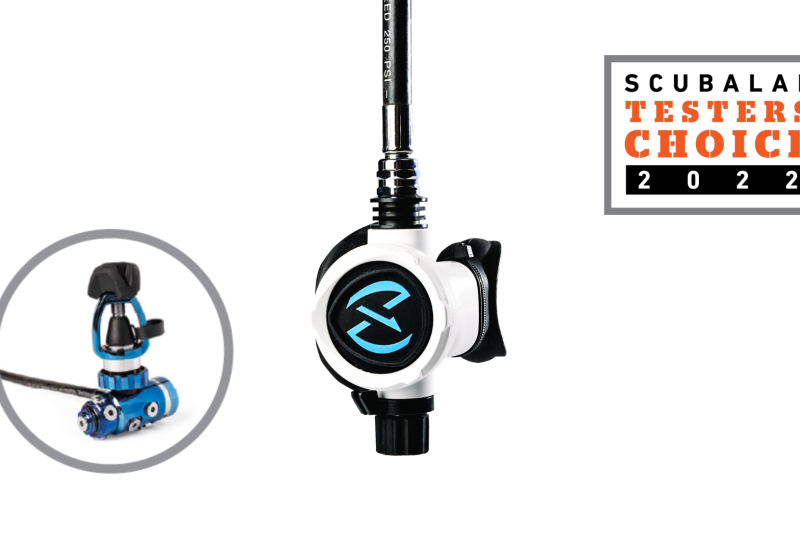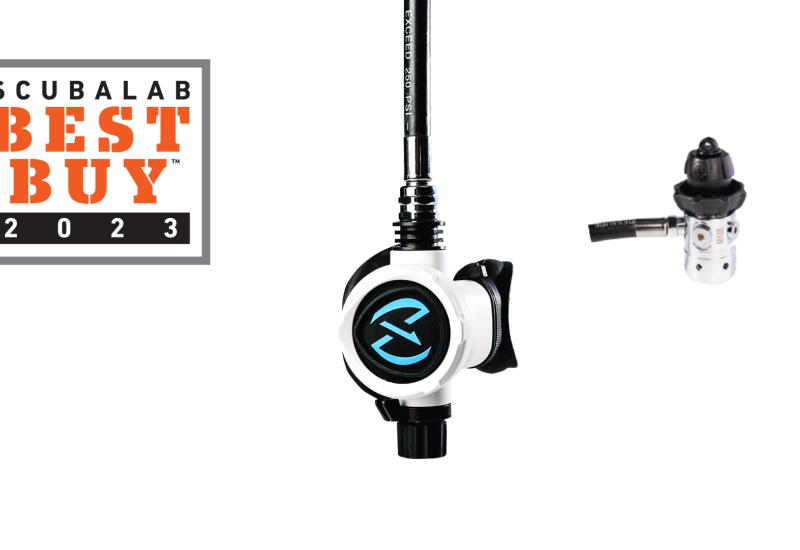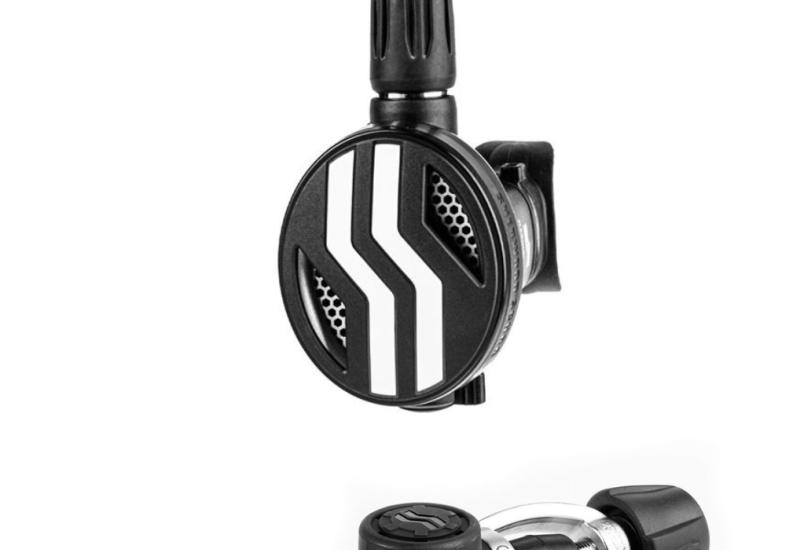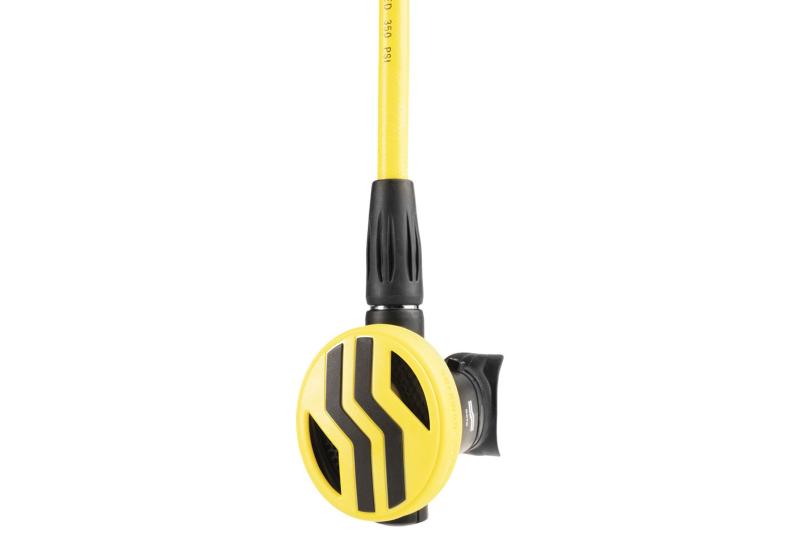17 New Regulators
By Bill Kendig
Photography by Joseph Byrd
 |
 |
Every year we hold our breath in anticipation (though not while diving, of course) of putting the latest and greatest new regulators to the test, and every year brings new surprises. Manufacturers continue to raise the bar with new materials, new designs and breathing performance that exceed what regulators offered just a few years ago. The 17 models in this year's review certainly do, and while they run the gamut in terms of size, styles, prices and features, they all offer the single most important thing every diver wants in a reg--reliable air delivery in the most demanding situations. We're pleased to say there's not a dog in the bunch.
But there are distinct differences you should consider when choosing a reg, and the following reviews, plus the charts on p. 88, are designed to do just that. Our testing process starts on the ANSTI breathing simulator, which precisely measures each reg's breathing resistance at four demanding depth/breathing rate combinations. Based on the total work of breathing measurement, we rate the reg's performance using a 2-to-5 scale (5=Excellent; 4=Very Good; 3=Good; 2=Fair). While breathing simulator results are important, they represent only half the story. To capture the complete picture, the Scuba Lab staff also evaluates each reg in seven areas of ergonomic performance during a series of test dives. Acting as your stand-in, they rate everything from ease of breathing and dryness in different positions to bubble interference and how easily the regs clear. Complete explanations and results of both types of testing can be found starting on p. 87. The following review summarizes the findings and divides the regs into two groups--Over $500 and Under $500.
Features to Consider on Your Next Reg
Number and placement of ports: More ports means easier hose routing options, as do rotating port turrets.
Dive/Pre-dive switch: A second-stage adjustment is useful to prevent free-flows on the surface.
Breathing resistance knob: Designed to be used underwater, it can be used to tune out positive pressure breathing and free-flows caused by current.
Balanced or Over-Balanced First Stage: All regulators in this review come with first stages that are either balanced or over-balanced. A balanced first stage is designed to maintain a steady intermediate pressure, regardless of cylinder pressure, for consistent performance. An over-balanced first stage takes it a step further by progressively increasing intermediate pressure as depth and gas density increases. You usually pay a little extra for a balanced or over-balanced first stage, but we think the performance benefits are worth it.
Balanced Second Stage: Air or pneumatically balanced second stages offer a reduced cracking effort, but in terms of overall performance, many second stages without balancing features perform on par with their balanced brothers.
Environmental Kits: Environmental kits keep water out the workings of the first stage, preventing contamination in dirty water or icing in cold water. It also stands to reason that keeping water out of the first stage's ambient spring chamber will have the added benefits of lower maintenance and increased durability. While some first stages come with an environmental kit as standard equipment, others offer it as an option or not at all.
Size and Weight: Regs in this review run the gamut from full-sized to ultra compact, but if there is a trend among manufacturers, it's toward smaller and lighter gear. First stages in particular seem to be losing weight and bulk, without sacrificing performance.
Dryness: Developing exhaust valves that don't leak has been the focus of many reg designers, and their efforts are paying off. All regulators in this review breathe bone dry with no spray or gurgle, even in face-up and head-down positions. This is a vast improvement over what we've seen in reg reviews of the past.
Nitrox Readiness: All regulators in this review are nitrox-ready up to 40 percent right out of the box. Some tech-oriented regs come completely O2 clean.
Piston or diaphragm first stage: To admit air from the tank into the regulator, first stages use either a piston or a diaphragm. Each has advantages and disadvantages, but both can offer excellent breathing performance.
Over $500
||||
|---|---|---|
|

|
| Aeris - Ion AT400 DVT|
Aeris - Ion AT400 DVT
Features: The AT400 DVT features an environmentally sealed, over-balanced diaphragm first stage with Oceanic's DVT feature, a retracting plug that keeps water out of the first-stage inlet even if the first stage is dunked without the dust cap in place. The new Ion's pneumatically balanced second stage is among the smallest of this test group, but it sports a large inhalation control knob to regulate breathing resistance at depth, a Dive/Pre-Dive switch to stop surface free-flows, and a stainless steel inline swivel that increases your range of motion.
Performance: The Ion feels light in the mouth due to its small size and ABS/Polycarbonate composite construction, plus it's a great breather, as evidenced by perfect scores on the ANSTI breathing machine. A large, flexible front purge cover is easy to find and clears the reg easily, while the swept-back exhaust tee provides better-than-average bubble displacement. The breathing resistance knob travels 2.5 full rotations, offering a substantial range of adjustment, and it clicks to let you know when the reg's fully detuned. The Dive/Pre-Dive switch, located directly above the breathing resistance knob, is a little small but not hard to find, and the inline swivel tracks nicely with head movement, reducing those annoying hose tugs.
Bottom Line: A great all-around performer at a reasonable price.
Price: $539.95
Weight: 2 pounds, 9 ounces.
Web: www.diveaeris.com
||||
|---|---|---|
|

|
| Aqua Lung - Legend Glacia ACD|
Aqua Lung - Legend Glacia ACD
Features: The Glacia is designed for use in cold water (50 degrees and below) with innovative features to prevent freeze-up. The over-balanced first stage is fitted with a heat exchanger that surrounds a dry environmental chamber. The pneumatically balanced second stage is fitted with an aluminum cover that also acts as a heat exchanger, and the smallish purge button is designed to regulate airflow during a purge to prevent freeflow-induced icing. An inline heat exchanger is found in the low-pressure hose between the first and second stages, and another small heat exchanger is located where the hose connects to the second stage. Bonus: The first stage comes with the Auto Closure Device (ACD), which seals the inlet as soon as the reg is removed from the cylinder valve. The second stage also comes with a lip shield and a choice of two mouthpieces.
Performance: The Glacia earned perfect scores on the ANSTI machine, and during our test dives, the reg breathed smooth and dry in all positions. It feels heavy in the mouth due to its metal front cover, but we liked the large venturi adjustment knob, which is easy to turn while wearing gloves. And the purge, while offering a shorter range of travel due to its flow control feature, was still able to clear the reg quickly and efficiently.
Bottom Line: The Glacia offers excellent breathing performance and while we didn't test its cold-water performance, the redundant heat exchanger design seems well thought out.
Price: $665
Weight: 3 pounds, 1 ounce.
Web: www.aqualung.com
||||
|---|---|---|
|

|
| Aqua Lung - Mikron|
Aqua Lung - Mikron
Features: Built for traveling, the Mikron features a balanced diaphragm first stage that isn't much bigger than a golf ball and a compact, pneumatically balanced second stage that measures just over 2 inches by 2 inches--all strung together with an ultra light, ultra-flexible braided hose. The result is a reg that, at 1 pound, 15 ounces, is 30 to 50 percent lighter than most and extremely easy to pack.
Performance: Smaller and lighter sometimes means a loss in breathing performance--not so with the Mikron. ANSTI tests showed this little breather can deliver lots of air, even at extreme depths and breathing rates. On our test dives, the Mikron was a smooth, dry breather in all positions and the compact second stage sits comfortably in the mouth and creates very little drag. One surprising find: The braided LP hose is remarkably flexible, even when pressurized, reducing hose pull on the mouthpiece. The pliable front-cover purge produces excellent clearing action, and because the reg has such a low-volume case, it can be cleared manually with a baby's breath. Bubble interference is just average, but not unexpected considering the tiny exhaust tee. The breathing resistance knob offers a reasonable range of adjustment in about one-and-a-quarter full rotations. For added comfort, the reg comes with both a ComfoBite and standard mouthpiece, plus a reuseable clamp for easy switching.
Bottom Line: The Mikron is lightweight and compact and still delivers top-notch breathing performance.
Price: $569
Weight: 1 pound, 15 ounces.
Web: www.aqualung.com
||||
|---|---|---|
|

|
| Dive Rite - Jetstream RG4500|
Dive Rite - Jetstream RG4500
Features: The Jetstream RG4500 comes tech-ready. The balanced diaphragm first stage comes standard with a DIN fitting (a yoke adapter is sold separately), five low-pressure ports and oxygen-compatible O-rings. It also uses a patented stainless-steel ball as a seating surface, a design that Dive Rite says virtually eliminates high-pressure seat wear. The side-purge Jetstream second stage uses a servo-valve in place of a traditional demand lever for extremely low inhalation effort. It comes with an on/off sensitivity switch to prevent surface free-flows, and can be worn on either the left or right side.
Performance: The Jetstream offers dry, effortless inhalation in both head-up and head-down positions. However, the exhaust valve and purge button are positioned to the side, which means exhalation resistance varies depending on how the regulator is positioned relative to the surface. If the exhaust valve is tilted toward the surface exhalation is easier, if tilted down, it's harder. On the breathing machine, the Jetstream delivered Excellent breathing scores in the test category most closely representing recreational diving, and Good breathing machine scores in all other tests. The second stage sits lightly in the mouth, and the purge button delivers a powerful blast of air. Bonus: Since there is no upside-down with this second stage, a hasty handoff to an out-of-air buddy is less complicated.
Bottom Line: A capable reg with tech-friendly design and features.
Price: $625
Weight: 2 pounds, 9 ounces (DIN).
Web: www.diverite.com
||||
|---|---|---|
|

|
| Hollis - 212 DC1 & DC2|
Hollis - 212 DC1 & DC2
Features: The first regulators in the new Hollis line of dive gear feature the pneumatically balanced 212 second stage paired with your choice of two over-balanced, environmentally sealed, diaphragm first stages--the DC1 and DC2. The DC1 is a traditional-looking first stage with a low-pressure port turret that simplifies hose routing; the DC2 is a lighter, more stylish and compact design.
Performance: The DC1 combo delivered perfect breathing machine scores. The DC2, while close on the DC1's heels, couldn't quite keep up in the more extreme breathing rate/depth categories. But the differences, while clearly detectable by the ANSTI machine, weren't evident in our test dives, where we found the real-world performance to be identical. The 212's mid-size frame is light and comfortable in the mouth, made even more so by the optional swivel that allows head movements without tugging on the hose. The patented Dynamic Adjustment knob is a clever way to adjust breathing performance: Dial in your preferred level of inhalation effort, then leave it alone--the reg will automatically compensate for depth changes. The venturi switch is effective at taming surface free-flows, and the large cover purge moves a lot of air when needed.
Bottom Line: Whether you go with the smaller, lighter 212 DC2 or prefer the convenience of the low-pressure port turret on the 212 DC1, you get top-shelf performance.
Price: $629.50
Weight: DC1--3 pounds; DC2--2 pounds, 12 ounces.
Web: www.hollisgear.com
||||
|---|---|---|
|

|
| Mares - Abyss 42 & 22|
Mares - Abyss 42 & 22
Features: The Abyss is a proven full-size, all-metal second stage that eliminates the user controls in favor of a Vortex Assisted Design, which uses a bypass tube to direct air right to the mouthpiece and reduce inhalation resistance. The MR22 balanced diaphragm first stage is another proven performer, though it's been redesigned for 2008 with a lighter, more streamlined form. The tiny MR42 is another balanced diaphragm design and Mares' most compact first stage--sort of the mini-me version of MR22. Both use a Tri-Material valve made of brass, soft polyurethane and heavy-duty polyurethane for longer life. They also incorporate a special Dynamic Flow Control low-pressure port that delivers maximum flow to the primary second stage.
Performance: The MR22 and the MR42 delivered near-identical performance, both on the breathing machine and on our test dives. ANSTI machine scores came in at Very Good across the board for the MR22 and in all but the most extreme breathing rate/depth category for the tiny MR42. But in the water we couldn't tell the difference between these regs--both breathe smooth and dry. The all-metal body of the Abyss second stage didn't create any noticeable weight or jaw fatigue issues, and it cleared nicely with a powerful purge.
Bottom Line: Both regs offer lots of performance in a compact, keep-it-simple package, but the tiny Abyss 42 is the choice if you do a lot of traveling.
Price: Abyss 42 $675, Abyss 22 $600
Weight: Abyss 42--2 pounds, 7 ounces; Abyss 22--2 pounds, 13 ounces.
Web: www.mares.com
||||
|---|---|---|
|

|
| Mares - Prestige 32 NTT|
Mares - Prestige 32 NTT
Features: The MR32 first stage is a balanced diaphragm design that incorporates the best proven features of other Mares regulators, including the Tri-Material valve for long life and a Dynamic Flow Control low-pressure port for maximum air delivery to the primary second stage. The new Prestige second stage is made of a lightweight technopolymer with what Mares calls NTT, or Nano Thermoconductive Technology. This material is designed to exchange heat better than standard plastic housings in order to improve the reg's cold-water performance. Another design innovation: The Dive/Pre-dive switch works not by spoiling airflow, but rather by preventing the demand lever from moving far enough to create a free-flow. In the Dive position it rotates completely out of the way for unrestricted breathing.
Performance: The Prestige 32 NTT offered Very Good to Good scores in the four ANSTI breathing machine tests. Underwater, the technopolymer second stage felt light and comfortable in the mouth and we found the large Dive/Pre-dive switch very easy to use. Breathing was nice and dry in all positions, and the reg cleared quickly and easily thanks to the large flexible purge cover.
Bottom Line: With a proven pedigree, the new Prestige 32 NTT offers good performance at a reasonable MSRP.
Price: $550
Weight: 2 pounds, 14 ounces.
Web: www.mares.com
||||
|---|---|---|
|

|
| Oceanic - EOS FDX10 DVT|
Oceanic - EOS FDX10 DVT
Features: The FDX-10 is an environmentally sealed, over-balanced diaphragm first stage featuring two high-pressure and four low-pressure ports, all angled to optimize comfortable hose routing. It also has DVT to protect the first-stage inlet. The new pneumatically balanced EOS second stage offers a light compact body with user controls--a large flow control adjustment knob and ratcheting Dive/Pre-dive switch--as well as an inline swivel and a sizeable front purge cover.
Performance: Underwater, the EOS midsize second-stage was light and comfortable in the mouth with a swivel that tracks small head movements, reducing jaw fatigue. The patented Dynamic Adjustment flow control knob allows you to lock in your ideal breathing resistance, and once set, the reg compensates for depth changes. Underwater, it worked well, maintaining easy breathing at depth. The Venturi switch has a ratcheting movement for fine-tuning and the large front cover purge was easy to find. On the ANSTI breathing machine, the EOS FDX10 produced a mix of Excellent to Very Good scores in the four test categories.
Bottom Line: This regulator comes fully loaded with all the extras and above-average breathing performance.
Price: $639.95
Weight: 2 pounds, 10 ounces.
||||
|---|---|---|
|

|
| Scubapro - MK25/G250V & MK17/G250V|
Scubapro - MK25/G250V & MK17/G250V
Features: The G250V is a re-released version of Scubapro's classic second stage, and the full-sized, pneumatically balanced breather is as popular as ever. It offers two user adjustments: a Venturi Initiated Vacuum Assist (VIVA) that controls surface free-flows, and a breathing resistance knob. Scubapro's flagship MK25 first stage is a balanced piston design with two high-pressure ports and five low-pressure ports on a turret to accommodate convenient hose routing. It also has an external intermediate pressure adjustment for maintaining peak performance between service intervals. If you prefer a balanced diaphragm first stage, the MK17 features a dry ambient chamber that shields the moving parts from cold and contaminated water. It offers two high-pressure ports and four low-pressure ports, all angled for direct routing.
Performance: Both combinations offer smooth, dry breathing in all positions, and the orthodontic mouthpiece made the G250V one of most comfortable in this test group. The center-case button purge is powerful, and the VIVA switch is extra-large, making it easy to grab. As a bonus, the purge button can be recessed during storage to preserve the life of the second stage seat. On the ANSTI breathing machine, both regs earned Excellent to Very Good scores.
Bottom Line: Take your pick--you can't go wrong with either of these top performers.
Price: MK 25/G250V $626; MK 17/G250V $595
Weight: MK 25/G250V--2 pounds, 12 ounces; MK 17/G250V--2 pounds, 13 ounces.
Web: www.scubapro.com
||||
|---|---|---|
|

|
| Sherwood Scuba - SR1|
Sherwood Scuba - SR1
Features: The new SR1 from Sherwood Scuba was the standout regulator of this review, offering innovative design, clever features and outstanding breathing performance. The first stage is polished chrome over brass with five low-pressure ports on a turret and two high-pressure ports. It's a balanced piston design, but with a unique air-filled dry-sealed spring chamber that is completely environmentally sealed. The pneumatically balanced second stage features a single control knob that simultaneously adjusts both the venturi control and breathing resistance. And between dives, a SMART demand lever lightens the load on the valve seat for extended life and performance. Bonus: The second stage also comes with an external fitting for adjusting lever height, making life easier for your technician.
Performance: Underwater, the SR1 delivers dry and effortless breathing in all positions, thanks in part to an oversized exhaust valve, which reduces exhalation resistance. This design helps reduce overall work of breathing, and yielded Excellent ANSTI machine scores in all tests. In fact, the SR1 was one of only four regs to earn perfect simulator scores. The flexible front-cover purge provides a forceful clearing action, and the low-profile exhaust tee does a good job of deflecting bubbles, both when stationary and when moving forward in the water.
Bottom Line: The SR1 is a solid breather, combining proven regulator design with cutting-edge features for excellent performance.
Price: $640
Weight: 2 pounds, 5 ounces.
Under $500
||||
|---|---|---|
|

|
| Cressi-sub - Ellipse Black/MC5|
Cressi-sub - Ellipse Black/MC5
Features: At just under 2 pounds, the Ellipse Black/MC5 is one of the lightest regulators of this test group and built to travel. The MC5 balanced-diaphragm first stage is a new design. Encased in a protective elastomer shell, it features three angled low-pressure ports and one high-pressure port. The Ellipse Black second stage is made of lightweight, high-impact thermopolymer and sports a full front-cover purge and a large dive/pre-dive switch.
Performance: Underwater, the compact second stage was light in the mouth, breathed dry in all positions and cleared easily, either with a puff of air or a blast from the big purge cover. Even though it was one of the smallest second stages in this review, it had one of the largest venturi controls and purge button, for easy operation, even with gloves. Exhaust bubbles were a little more noticeable than other regs in this review, but that's to be expected with such a compact exhaust tee. The top-mounted venturi adjustment lever was easy to find and effective in preventing surface free-flows. During in-water dives, we rated it highly for comfort thanks to a light feel and a soft mouthpiece. On the ANSTI breathing machine, it earned Very Good scores within recreational diving range and Good scores under extreme conditions.
Bottom Line: Extremely lightweight and priced at a very attractive MSRP.
Price: $299
Weight: 1 pound, 15 ounces.
Web: www.cressisubusa.com
||||
|---|---|---|
|

|
| Dive Rite - 3000|
Dive Rite - 3000
Features: This tech-ready reg pairs Dive Rite's proven 1208 diaphragm first stage with the new 3000-series second stage to create a full-featured breather. The first stage offers two high-pressure ports with four low-pressure ports located on a rotating turret to provide easy hose placement. It comes standard with a 300-bar DIN connector and yoke adapter and features oxygen-compatible Viton O-rings. The new 3000 pneumatically balanced second stage presents a full-size body with large flow control and venturi adjustments. All internal moving parts are Teflon-coated for cold water and use Viton O-rings with oxygen-compatible lubricant.
Performance: The reg delivered Very Good performance in all but the most extreme breathing machine tests and in fact, turned in the best overall ANSTI performance of any regulator in the Under $500 class. Like dialing in your precise breathing resistance? The flow control knob on the 3000 offers 4.5 full rotations and covers a noticeably wide range of control over breathing resistance. In Ergo tests, this new 3000 stage offered very good performance across the board. Its plastic case was light in the mouth, and the full front-cover purge is flexible and clears easily. It was also a dry, stable breather that offered great all-around performance during our test dives.
Bottom Line: The 3000 offers very good performance, versatile user controls and is ready for DIN or yoke tank connection.
Price: $450
Weight: 3 pounds, 1 ounce (yoke).
Web: www.diverite.com
||||
|---|---|---|
|

|
| Mares - Prestige 12|
Mares - Prestige 12
Features: While it's in the economy class of regulators, the MR12T balanced diaphragm first stage has been and continues to be a reliable workhorse. It has all the performance features of the company's high-end models, including the new Tri-Material first-stage valve and the Dynamic Flow Control low-pressure port that's dedicated to the primary second stage. The Prestige second stage features a mid-size case made from durable thermoplastic and a simplified design without user adjustments. It also has a large flexible purge cover.
Performance: On our test dives, we found the Prestige light, comfortable and easy to use. It offered worry-free, dry breathing in all swimming positions, and on the ANSTI machine, it turned in work of breathing numbers that ranged from Very Good to Good in all depth/workload tests. The plastic second stage was comfortable with a soft mouthpiece and sits lightly and comfortably in the mouth. A small exhaust tee reduces drag, but the trade-off is greater bubble interference. All-in-all, we found the Prestige 12 to be a reliable regulator with the performance and simplicity that make it an ideal entry-level reg or a trusty backup.
Bottom Line: This is a simple, dependable workhorse reg.
Price: $400
Weight: 2 pounds, 6 ounces.
Web: www.diverite.com
||||
|---|---|---|
|

|
| Tusa - RS-530|
Tusa - RS-530
Features: This combination starts with Tusa's compact R-500 balanced piston first stage, which features a full complement of four low-pressure and two high-pressure ports and is equipped with a quick-adjustment screw for fine-tuning performance. At the end of the low-pressure hose is the company's S-30 thermoplastic second stage featuring a breathing resistance adjustment knob for on-the-swim flow control. It also has a new orthodontic mouthpiece and a chrome trim ring locking down a full front-cover purge.
Performance: On our test dives, we noticed the mouthpiece right away. It features elongated bite tabs and required less bite pressure to hold comfortably in the mouth. The reg earned Very Good ratings in most ergo categories. The breathing resistance knob is clearly marked and offers a full turn of adjustment with an indexed click that allows precise tuning, and in the wide-open setting, cracking effort was followed by a dry, smooth inhalation. It also offered minimal bubble interference. The center purge is easy to locate and quick to clear. On the breathing machine, it excelled at recreational depths and workloads while receiving Very Good and Good scores in the other three tests.
Bottom Line: The RS-530 is a comfortable reg with the added bonus of being the least expensive balanced piston first stage in this review.
Price: $399
Weight: 2 pounds, 7 ounces.
Web: www.diverite.com
Breathing Rates and Depths
Regulators are tested at four different RMV/depth combinations (RMV stands for Respiratory Minute Volumes--basically the amount of gas that is ventilated through the lungs in one minute). Here are the tests and what they represent:
37.5 RMV @ 132 fsw A somewhat aggressive breathing rate at the maximum recreational diving depth. A physically fit recreational diver might breathe at this rate while swimming a long distance. (A relaxed diver on a drift dive will probably be breathing at 22 RMV or less.) A diver could theoretically maintain 37.5 RMV for 5 minutes or longer without becoming significantly winded.
75 RMV @ 132 fsw An extremely aggressive breathing rate at the maximum recreational diving depth. A diver in excellent condition can breathe at 75 RMV for about one minute. This test represents how a reg might perform with a single diver breathing at an extremely heavy work rate. It also serves as a loose simulation of the stress a reg would be under if two divers were breathing off the same first stage in an air-sharing situation. Only the U.S. Navy and Scuba Lab use this breathing rate to help identify the outer limits of a reg's performance.
62.5 RMV @ 165 fsw All regs sold in the European Common Market must pass a test standard known as EN250, which uses this RMV/depth as its benchmark. For this reason, it's also the depth and breathing rate most commonly used by manufacturers to test regulators. This is a very aggressive breathing rate. A recreational diver in excellent condition chasing a bat ray through open water would probably be able to maintain 62.5 RMV for only a few minutes.
62.5 RMV @ 198 fsw This is the U.S. Navy's Class A test depth and breathing rate, although they use a higher supply pressure than our standard 725-760 psi. We conduct this extreme test (no diver should ever breath this aggressively at this great a depth with this little air left) to explore the outer limits of a reg's performance.
Scoring the Results
A machine as accurate as the ANSTI simulator can differentiate j/l measurements to tenths and even hundredths of a point. Human divers, however, can't detect differences much smaller than about 0.5 j/l. So for the sake of simplicity, we translate j/l measurements into scores on a 2 to 5 scale as follows:
5 = Excellent: A total WOB of 1.05 j/l or less.
4 = Very Good: A total WOB of 1.06 to 1.55 j/l.
3 = Good: A total WOB from 1.56 to 2.25 j/l.
2 = Fair: A total WOB of 2.26 to 3.0 j/l.
If a reg is unable to achieve the RMV/Depth category, its maximum depth within test parameters is recorded instead of a score.
How and Why We Test Regulators
The goal of our exclusive Scuba Lab Reviews (found only in Scuba Diving magazine and archived on scuba diving.com) is to help you be an informed consumer of dive gear.
To fulfill this mission when testing regulators, we use an industry-standard ANSTI wet breathing machine, which is capable of measuring minute differences in the inhalation and exhalation resistance at a variety of depths and breathing rates. Following internationally accepted test standards, a regulator's work of breathing (WOB) is measured in joules per liter for each complete inhale/exhale cycle, during which the highest inhale or exhalation pressure experienced by the "diver" should never exceed 25 millibars or a total WOB of 3 j/l.
If a reg exceeds either parameter, it "fails" our test, but that doesn't mean that it stops delivering air--only that the breathing resistance at some point in the cycle is higher than what is common for most modern regulators. All simulator tests are performed at a supply pressure of 725-760 psi. If a regulator can perform well at this supply pressure, it will perform as well or better at higher supply pressures.
By Bill Kendig
Photography by Joseph Byrd
|| |---|
|
|| |---|
|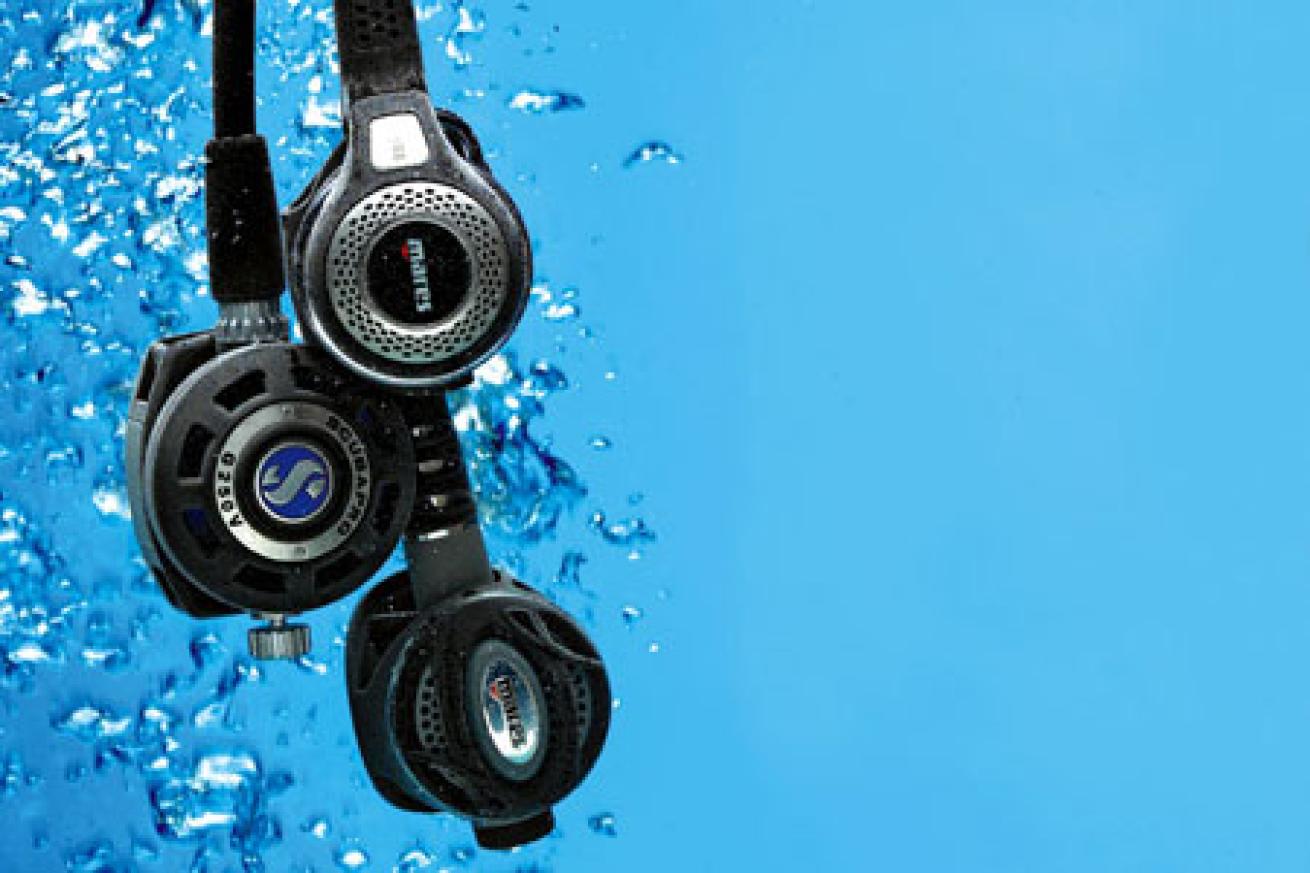
|
Every year we hold our breath in anticipation (though not while diving, of course) of putting the latest and greatest new regulators to the test, and every year brings new surprises. Manufacturers continue to raise the bar with new materials, new designs and breathing performance that exceed what regulators offered just a few years ago. The 17 models in this year's review certainly do, and while they run the gamut in terms of size, styles, prices and features, they all offer the single most important thing every diver wants in a reg--reliable air delivery in the most demanding situations. We're pleased to say there's not a dog in the bunch.
But there are distinct differences you should consider when choosing a reg, and the following reviews, plus the charts on p. 88, are designed to do just that. Our testing process starts on the ANSTI breathing simulator, which precisely measures each reg's breathing resistance at four demanding depth/breathing rate combinations. Based on the total work of breathing measurement, we rate the reg's performance using a 2-to-5 scale (5=Excellent; 4=Very Good; 3=Good; 2=Fair). While breathing simulator results are important, they represent only half the story. To capture the complete picture, the Scuba Lab staff also evaluates each reg in seven areas of ergonomic performance during a series of test dives. Acting as your stand-in, they rate everything from ease of breathing and dryness in different positions to bubble interference and how easily the regs clear. Complete explanations and results of both types of testing can be found starting on p. 87. The following review summarizes the findings and divides the regs into two groups--Over $500 and Under $500.
Features to Consider on Your Next Reg
Number and placement of ports: More ports means easier hose routing options, as do rotating port turrets.
Dive/Pre-dive switch: A second-stage adjustment is useful to prevent free-flows on the surface.
Breathing resistance knob: Designed to be used underwater, it can be used to tune out positive pressure breathing and free-flows caused by current.
Balanced or Over-Balanced First Stage: All regulators in this review come with first stages that are either balanced or over-balanced. A balanced first stage is designed to maintain a steady intermediate pressure, regardless of cylinder pressure, for consistent performance. An over-balanced first stage takes it a step further by progressively increasing intermediate pressure as depth and gas density increases. You usually pay a little extra for a balanced or over-balanced first stage, but we think the performance benefits are worth it.
Balanced Second Stage: Air or pneumatically balanced second stages offer a reduced cracking effort, but in terms of overall performance, many second stages without balancing features perform on par with their balanced brothers.
Environmental Kits: Environmental kits keep water out the workings of the first stage, preventing contamination in dirty water or icing in cold water. It also stands to reason that keeping water out of the first stage's ambient spring chamber will have the added benefits of lower maintenance and increased durability. While some first stages come with an environmental kit as standard equipment, others offer it as an option or not at all.
Size and Weight: Regs in this review run the gamut from full-sized to ultra compact, but if there is a trend among manufacturers, it's toward smaller and lighter gear. First stages in particular seem to be losing weight and bulk, without sacrificing performance.
Dryness: Developing exhaust valves that don't leak has been the focus of many reg designers, and their efforts are paying off. All regulators in this review breathe bone dry with no spray or gurgle, even in face-up and head-down positions. This is a vast improvement over what we've seen in reg reviews of the past.
Nitrox Readiness: All regulators in this review are nitrox-ready up to 40 percent right out of the box. Some tech-oriented regs come completely O2 clean.
Piston or diaphragm first stage: To admit air from the tank into the regulator, first stages use either a piston or a diaphragm. Each has advantages and disadvantages, but both can offer excellent breathing performance.
Over $500
|||| |---|---|---|
|<
table>
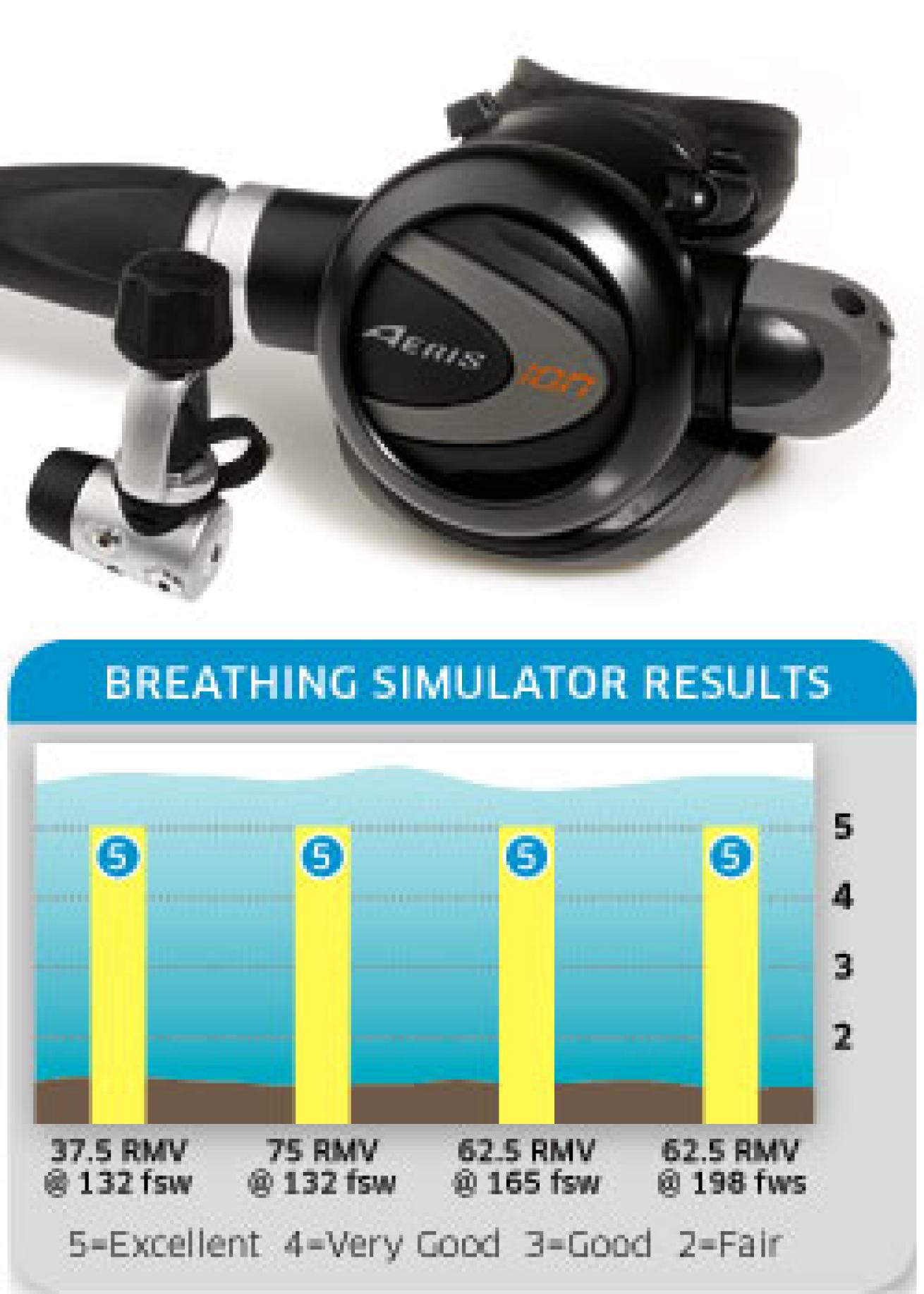
| | Aeris - Ion AT400 DVT|
Features: The AT400 DVT features an environmentally sealed, over-balanced diaphragm first stage with Oceanic's DVT feature, a retracting plug that keeps water out of the first-stage inlet even if the first stage is dunked without the dust cap in place. The new Ion's pneumatically balanced second stage is among the smallest of this test group, but it sports a large inhalation control knob to regulate breathing resistance at depth, a Dive/Pre-Dive switch to stop surface free-flows, and a stainless steel inline swivel that increases your range of motion.
Performance: The Ion feels light in the mouth due to its small size and ABS/Polycarbonate composite construction, plus it's a great breather, as evidenced by perfect scores on the ANSTI breathing machine. A large, flexible front purge cover is easy to find and clears the reg easily, while the swept-back exhaust tee provides better-than-average bubble displacement. The breathing resistance knob travels 2.5 full rotations, offering a substantial range of adjustment, and it clicks to let you know when the reg's fully detuned. The Dive/Pre-Dive switch, located directly above the breathing resistance knob, is a little small but not hard to find, and the inline swivel tracks nicely with head movement, reducing those annoying hose tugs.
Bottom Line: A great all-around performer at a reasonable price.
Price: $539.95
Weight: 2 pounds, 9 ounces.
Web: www.diveaeris.com
|||| |---|---|---|
|<
table>
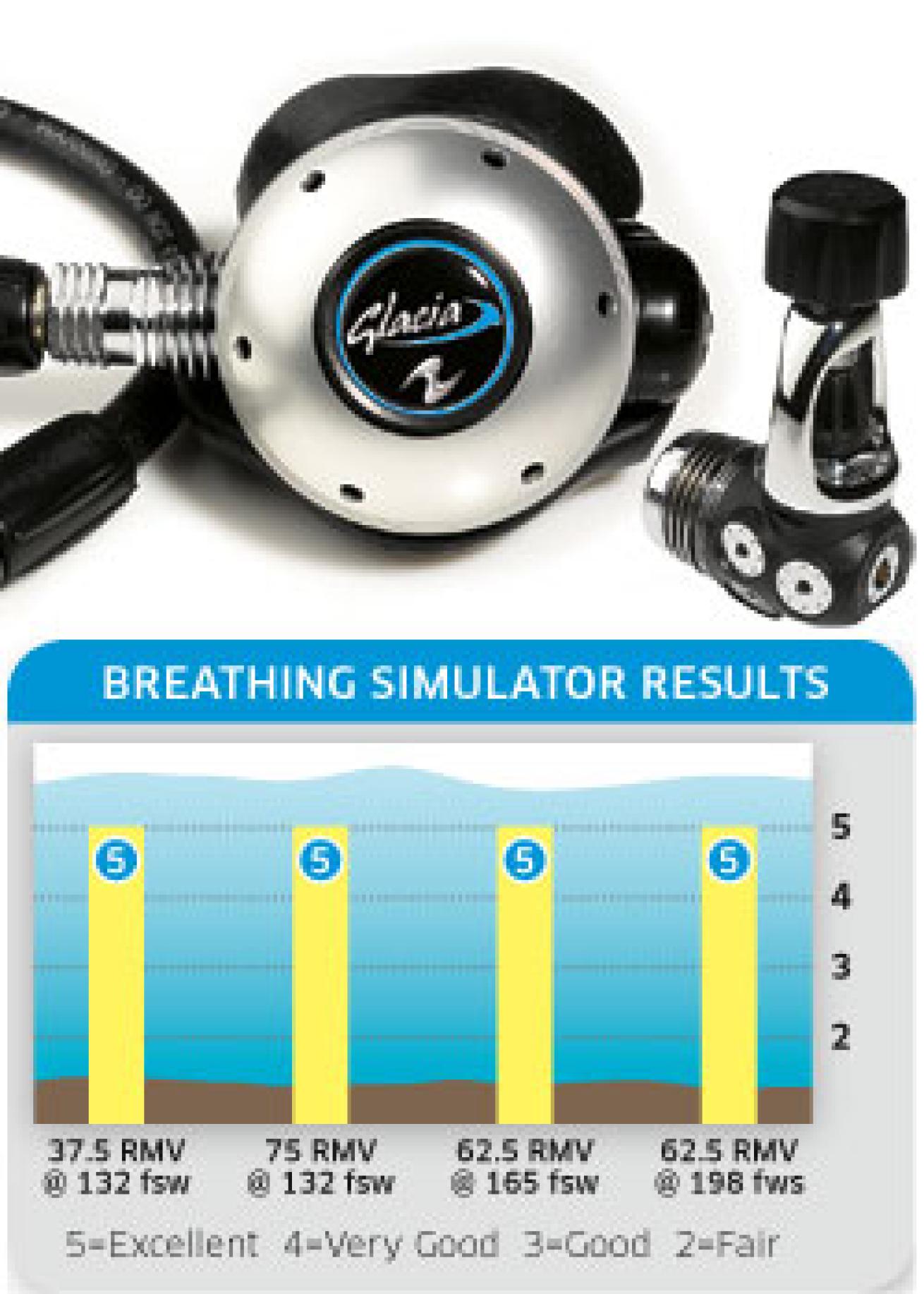
| | Aqua Lung - Legend Glacia ACD|
Features: The Glacia is designed for use in cold water (50 degrees and below) with innovative features to prevent freeze-up. The over-balanced first stage is fitted with a heat exchanger that surrounds a dry environmental chamber. The pneumatically balanced second stage is fitted with an aluminum cover that also acts as a heat exchanger, and the smallish purge button is designed to regulate airflow during a purge to prevent freeflow-induced icing. An inline heat exchanger is found in the low-pressure hose between the first and second stages, and another small heat exchanger is located where the hose connects to the second stage. Bonus: The first stage comes with the Auto Closure Device (ACD), which seals the inlet as soon as the reg is removed from the cylinder valve. The second stage also comes with a lip shield and a choice of two mouthpieces.
Performance: The Glacia earned perfect scores on the ANSTI machine, and during our test dives, the reg breathed smooth and dry in all positions. It feels heavy in the mouth due to its metal front cover, but we liked the large venturi adjustment knob, which is easy to turn while wearing gloves. And the purge, while offering a shorter range of travel due to its flow control feature, was still able to clear the reg quickly and efficiently.
Bottom Line: The Glacia offers excellent breathing performance and while we didn't test its cold-water performance, the redundant heat exchanger design seems well thought out.
Price: $665
Weight: 3 pounds, 1 ounce.
Web: www.aqualung.com
|||| |---|---|---|
|<
table>
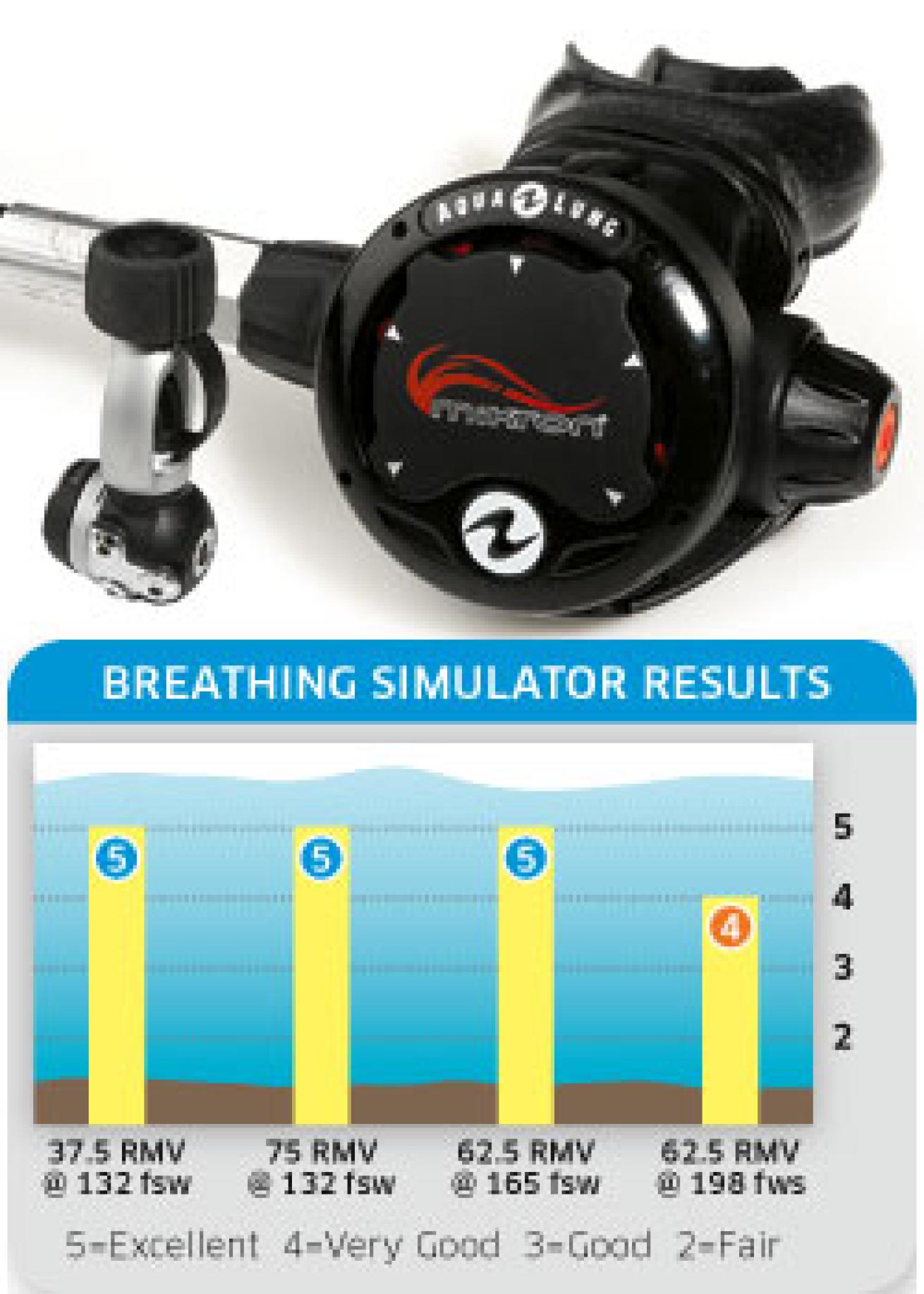
| | Aqua Lung - Mikron|
Features: Built for traveling, the Mikron features a balanced diaphragm first stage that isn't much bigger than a golf ball and a compact, pneumatically balanced second stage that measures just over 2 inches by 2 inches--all strung together with an ultra light, ultra-flexible braided hose. The result is a reg that, at 1 pound, 15 ounces, is 30 to 50 percent lighter than most and extremely easy to pack.
Performance: Smaller and lighter sometimes means a loss in breathing performance--not so with the Mikron. ANSTI tests showed this little breather can deliver lots of air, even at extreme depths and breathing rates. On our test dives, the Mikron was a smooth, dry breather in all positions and the compact second stage sits comfortably in the mouth and creates very little drag. One surprising find: The braided LP hose is remarkably flexible, even when pressurized, reducing hose pull on the mouthpiece. The pliable front-cover purge produces excellent clearing action, and because the reg has such a low-volume case, it can be cleared manually with a baby's breath. Bubble interference is just average, but not unexpected considering the tiny exhaust tee. The breathing resistance knob offers a reasonable range of adjustment in about one-and-a-quarter full rotations. For added comfort, the reg comes with both a ComfoBite and standard mouthpiece, plus a reuseable clamp for easy switching.
Bottom Line: The Mikron is lightweight and compact and still delivers top-notch breathing performance.
Price: $569
Weight: 1 pound, 15 ounces.
Web: www.aqualung.com
|||| |---|---|---|
|<
table>
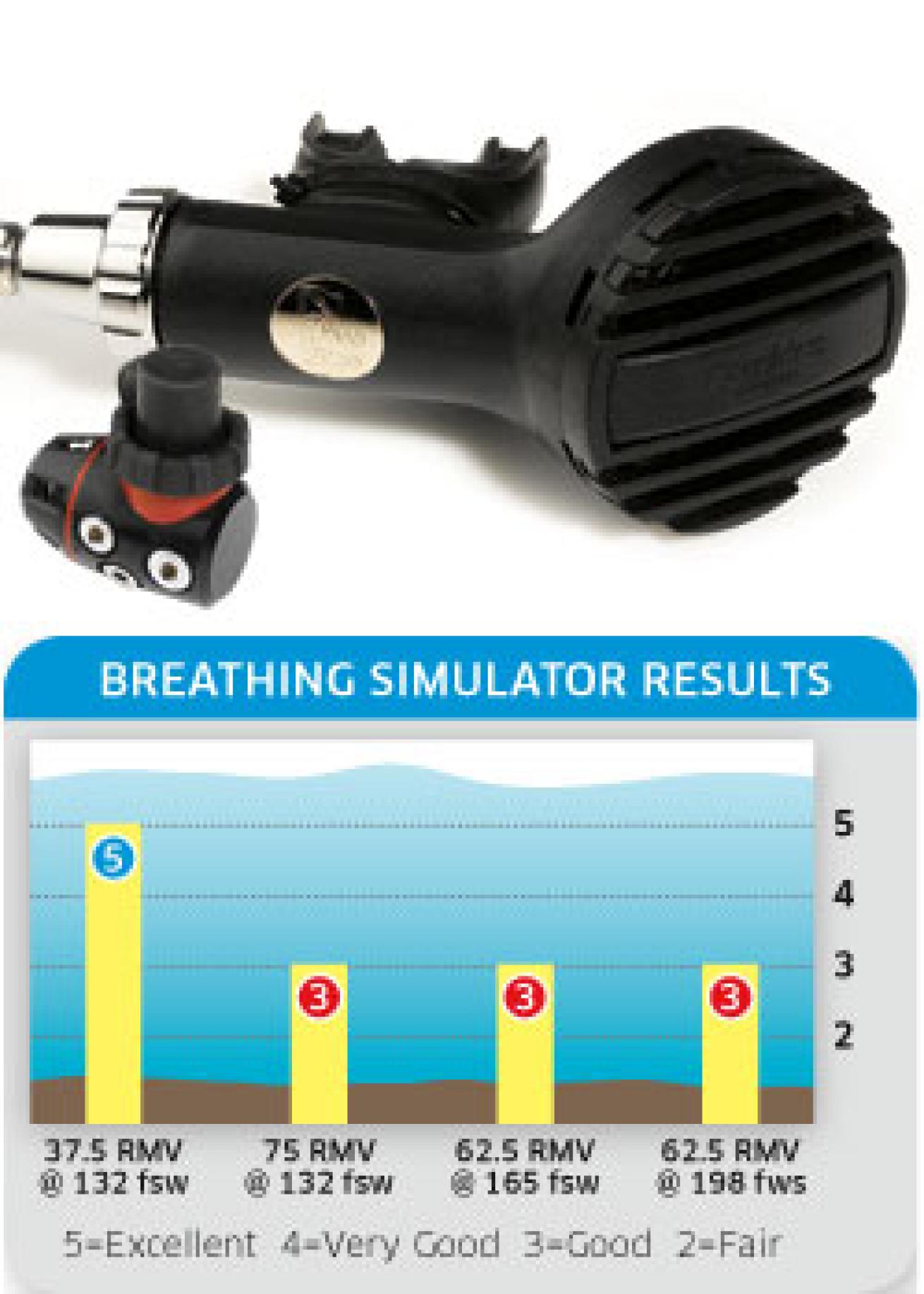
| | Dive Rite - Jetstream RG4500|
Features: The Jetstream RG4500 comes tech-ready. The balanced diaphragm first stage comes standard with a DIN fitting (a yoke adapter is sold separately), five low-pressure ports and oxygen-compatible O-rings. It also uses a patented stainless-steel ball as a seating surface, a design that Dive Rite says virtually eliminates high-pressure seat wear. The side-purge Jetstream second stage uses a servo-valve in place of a traditional demand lever for extremely low inhalation effort. It comes with an on/off sensitivity switch to prevent surface free-flows, and can be worn on either the left or right side.
Performance: The Jetstream offers dry, effortless inhalation in both head-up and head-down positions. However, the exhaust valve and purge button are positioned to the side, which means exhalation resistance varies depending on how the regulator is positioned relative to the surface. If the exhaust valve is tilted toward the surface exhalation is easier, if tilted down, it's harder. On the breathing machine, the Jetstream delivered Excellent breathing scores in the test category most closely representing recreational diving, and Good breathing machine scores in all other tests. The second stage sits lightly in the mouth, and the purge button delivers a powerful blast of air. Bonus: Since there is no upside-down with this second stage, a hasty handoff to an out-of-air buddy is less complicated.
Bottom Line: A capable reg with tech-friendly design and features.
Price: $625
Weight: 2 pounds, 9 ounces (DIN).
Web: www.diverite.com
|||| |---|---|---|
|<
table>
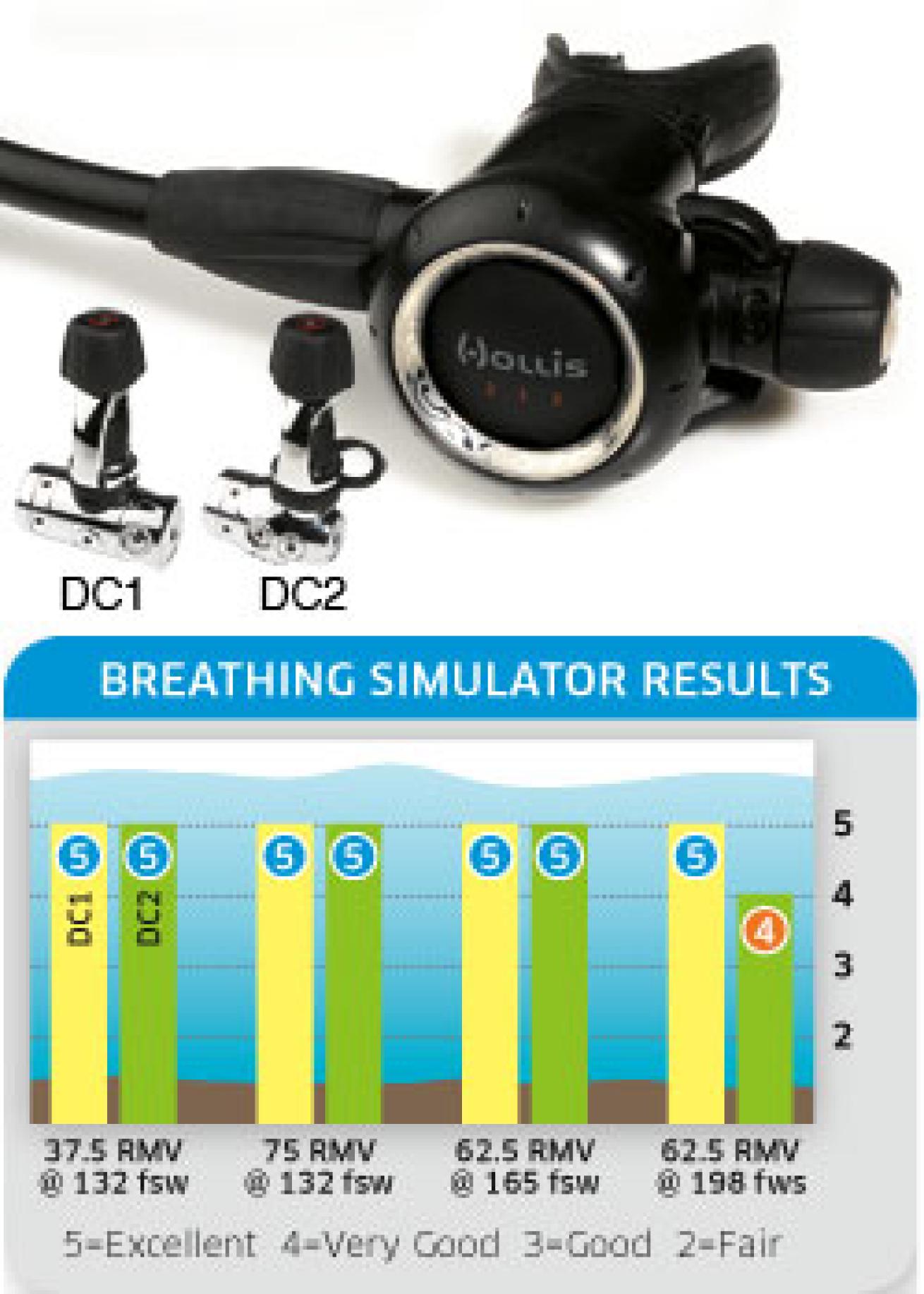
| | Hollis - 212 DC1 & DC2|
Features: The first regulators in the new Hollis line of dive gear feature the pneumatically balanced 212 second stage paired with your choice of two over-balanced, environmentally sealed, diaphragm first stages--the DC1 and DC2. The DC1 is a traditional-looking first stage with a low-pressure port turret that simplifies hose routing; the DC2 is a lighter, more stylish and compact design.
Performance: The DC1 combo delivered perfect breathing machine scores. The DC2, while close on the DC1's heels, couldn't quite keep up in the more extreme breathing rate/depth categories. But the differences, while clearly detectable by the ANSTI machine, weren't evident in our test dives, where we found the real-world performance to be identical. The 212's mid-size frame is light and comfortable in the mouth, made even more so by the optional swivel that allows head movements without tugging on the hose. The patented Dynamic Adjustment knob is a clever way to adjust breathing performance: Dial in your preferred level of inhalation effort, then leave it alone--the reg will automatically compensate for depth changes. The venturi switch is effective at taming surface free-flows, and the large cover purge moves a lot of air when needed.
Bottom Line: Whether you go with the smaller, lighter 212 DC2 or prefer the convenience of the low-pressure port turret on the 212 DC1, you get top-shelf performance.
Price: $629.50
Weight: DC1--3 pounds; DC2--2 pounds, 12 ounces.
Web: www.hollisgear.com
|||| |---|---|---|
|<
table>
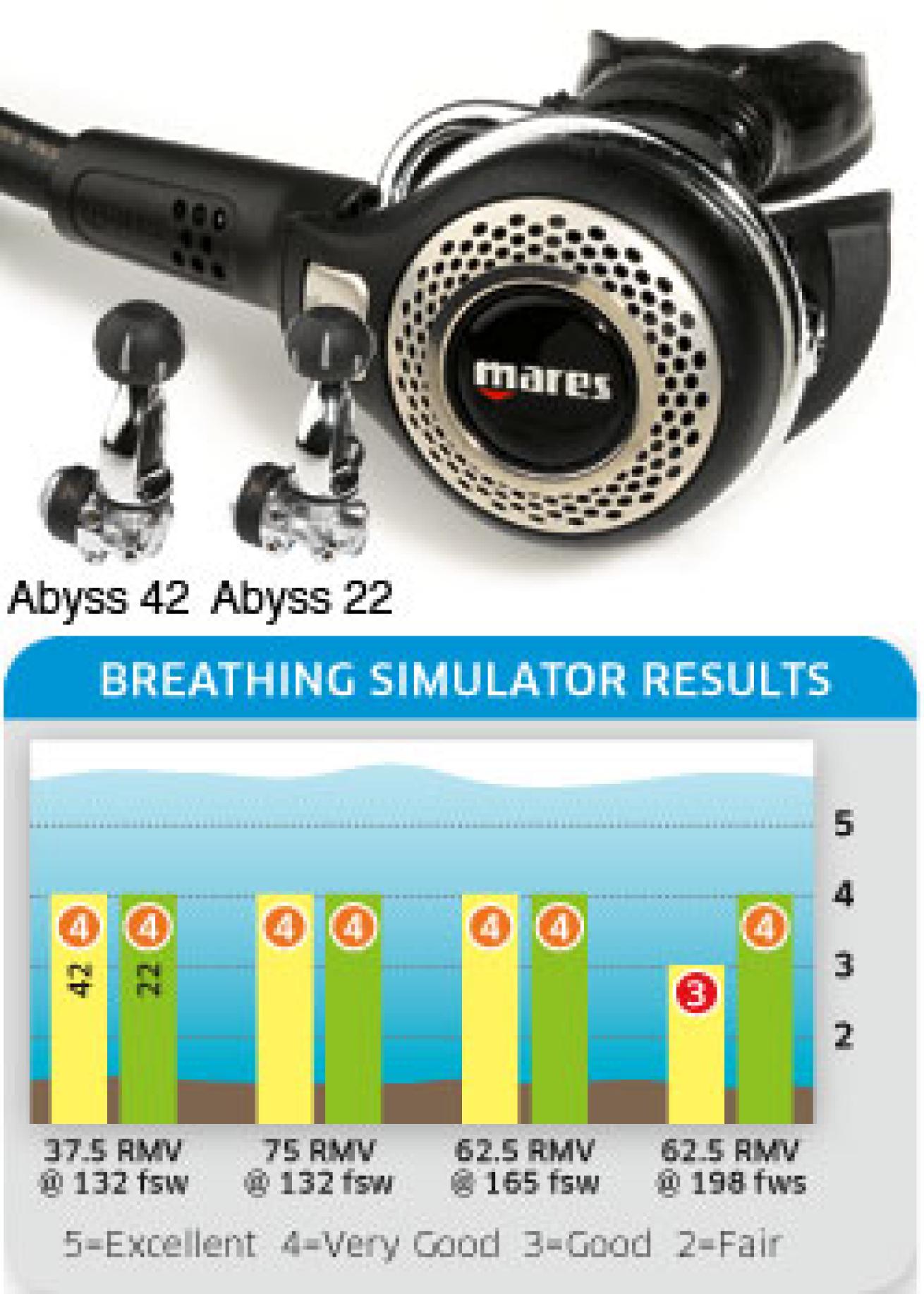
| | Mares - Abyss 42 & 22|
Features: The Abyss is a proven full-size, all-metal second stage that eliminates the user controls in favor of a Vortex Assisted Design, which uses a bypass tube to direct air right to the mouthpiece and reduce inhalation resistance. The MR22 balanced diaphragm first stage is another proven performer, though it's been redesigned for 2008 with a lighter, more streamlined form. The tiny MR42 is another balanced diaphragm design and Mares' most compact first stage--sort of the mini-me version of MR22. Both use a Tri-Material valve made of brass, soft polyurethane and heavy-duty polyurethane for longer life. They also incorporate a special Dynamic Flow Control low-pressure port that delivers maximum flow to the primary second stage.
Performance: The MR22 and the MR42 delivered near-identical performance, both on the breathing machine and on our test dives. ANSTI machine scores came in at Very Good across the board for the MR22 and in all but the most extreme breathing rate/depth category for the tiny MR42. But in the water we couldn't tell the difference between these regs--both breathe smooth and dry. The all-metal body of the Abyss second stage didn't create any noticeable weight or jaw fatigue issues, and it cleared nicely with a powerful purge.
Bottom Line: Both regs offer lots of performance in a compact, keep-it-simple package, but the tiny Abyss 42 is the choice if you do a lot of traveling.
Price: Abyss 42 $675, Abyss 22 $600
Weight: Abyss 42--2 pounds, 7 ounces; Abyss 22--2 pounds, 13 ounces.
Web: www.mares.com
|||| |---|---|---|
|<
table>
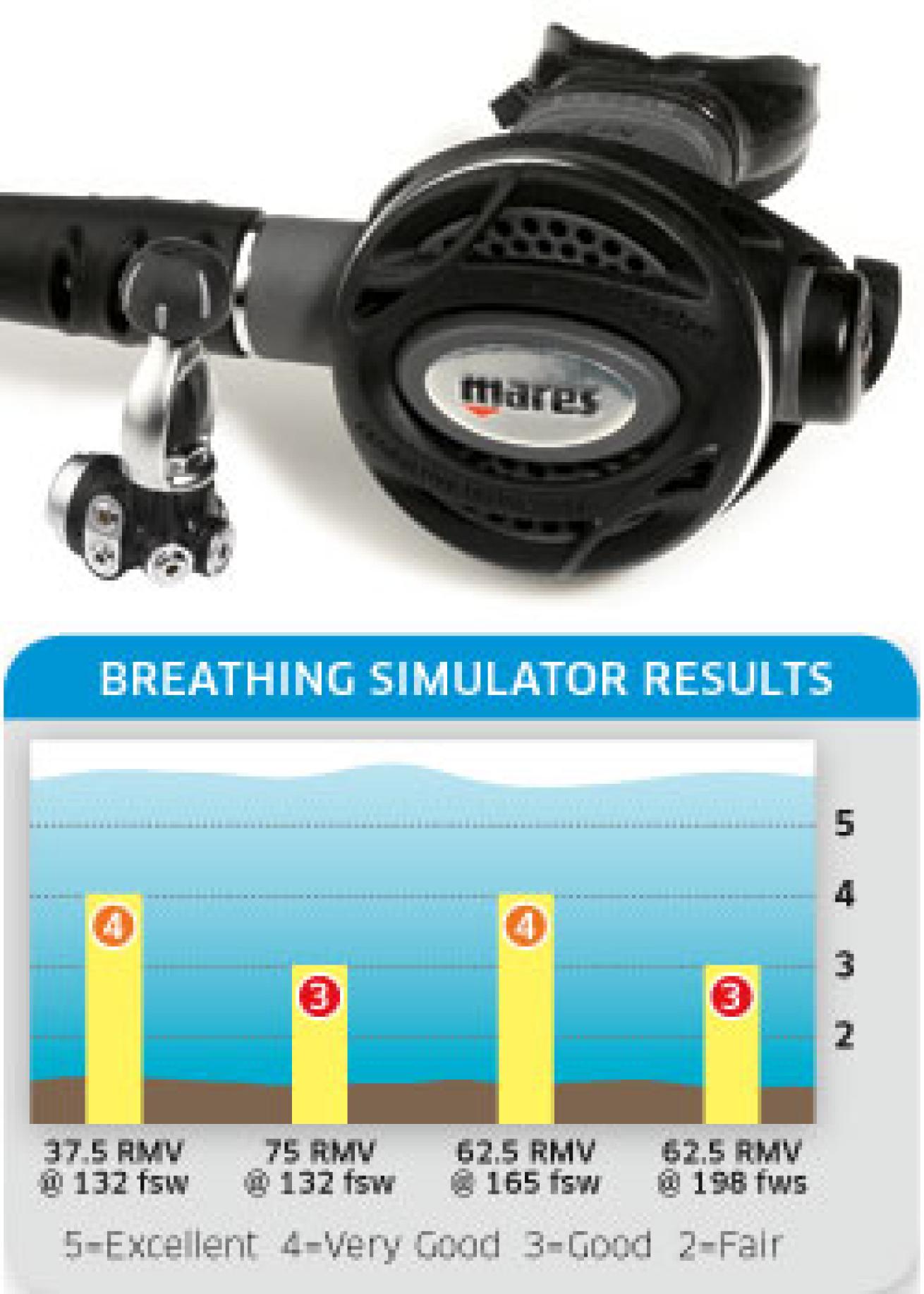
| | Mares - Prestige 32 NTT|
Features: The MR32 first stage is a balanced diaphragm design that incorporates the best proven features of other Mares regulators, including the Tri-Material valve for long life and a Dynamic Flow Control low-pressure port for maximum air delivery to the primary second stage. The new Prestige second stage is made of a lightweight technopolymer with what Mares calls NTT, or Nano Thermoconductive Technology. This material is designed to exchange heat better than standard plastic housings in order to improve the reg's cold-water performance. Another design innovation: The Dive/Pre-dive switch works not by spoiling airflow, but rather by preventing the demand lever from moving far enough to create a free-flow. In the Dive position it rotates completely out of the way for unrestricted breathing.
Performance: The Prestige 32 NTT offered Very Good to Good scores in the four ANSTI breathing machine tests. Underwater, the technopolymer second stage felt light and comfortable in the mouth and we found the large Dive/Pre-dive switch very easy to use. Breathing was nice and dry in all positions, and the reg cleared quickly and easily thanks to the large flexible purge cover.
Bottom Line: With a proven pedigree, the new Prestige 32 NTT offers good performance at a reasonable MSRP.
Price: $550
Weight: 2 pounds, 14 ounces.
Web: www.mares.com
|||| |---|---|---|
|<
table>
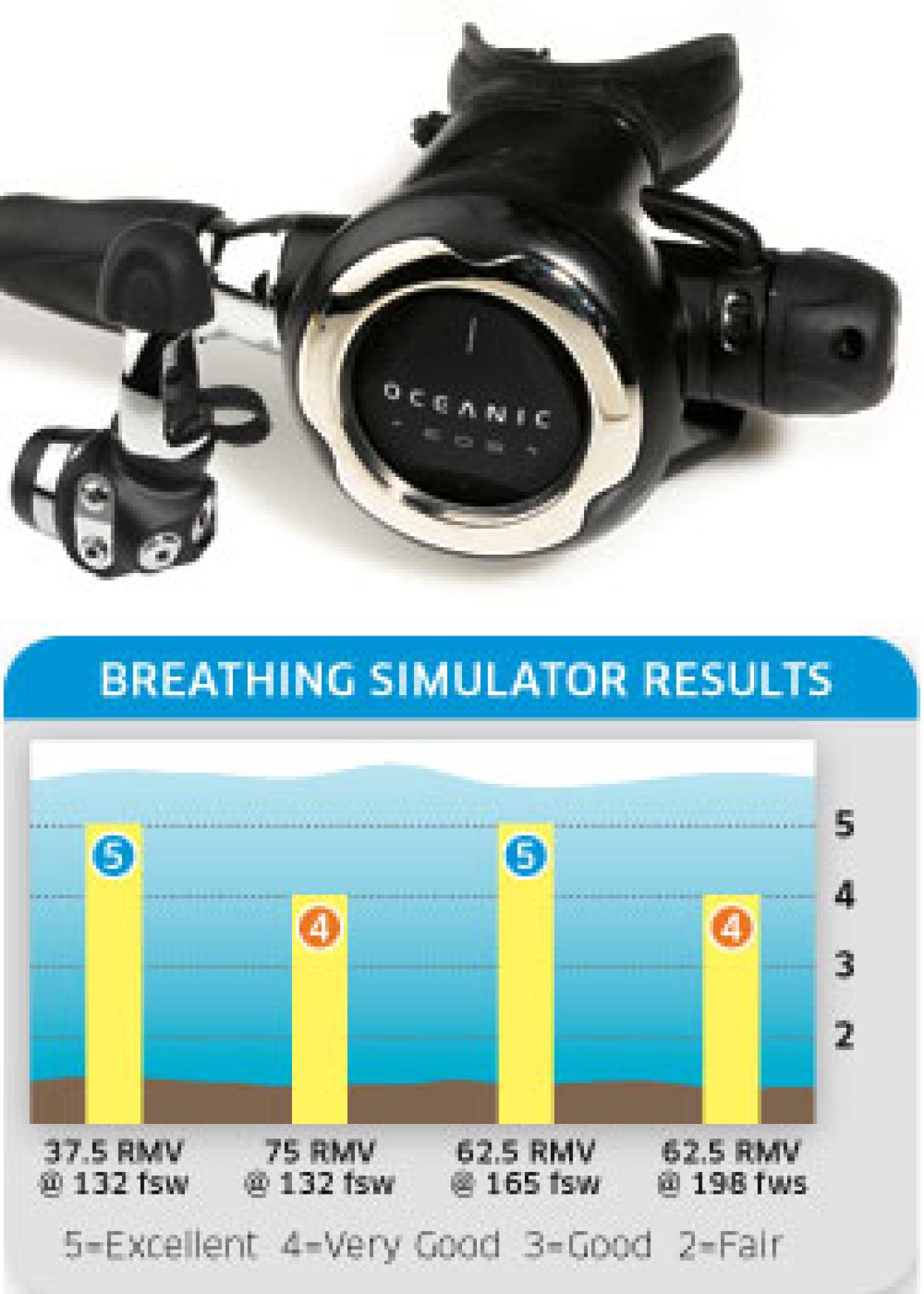
| | Oceanic - EOS FDX10 DVT|
Features: The FDX-10 is an environmentally sealed, over-balanced diaphragm first stage featuring two high-pressure and four low-pressure ports, all angled to optimize comfortable hose routing. It also has DVT to protect the first-stage inlet. The new pneumatically balanced EOS second stage offers a light compact body with user controls--a large flow control adjustment knob and ratcheting Dive/Pre-dive switch--as well as an inline swivel and a sizeable front purge cover.
Performance: Underwater, the EOS midsize second-stage was light and comfortable in the mouth with a swivel that tracks small head movements, reducing jaw fatigue. The patented Dynamic Adjustment flow control knob allows you to lock in your ideal breathing resistance, and once set, the reg compensates for depth changes. Underwater, it worked well, maintaining easy breathing at depth. The Venturi switch has a ratcheting movement for fine-tuning and the large front cover purge was easy to find. On the ANSTI breathing machine, the EOS FDX10 produced a mix of Excellent to Very Good scores in the four test categories.
Bottom Line: This regulator comes fully loaded with all the extras and above-average breathing performance.
Price: $639.95
Weight: 2 pounds, 10 ounces.
|||| |---|---|---|
|<
table>
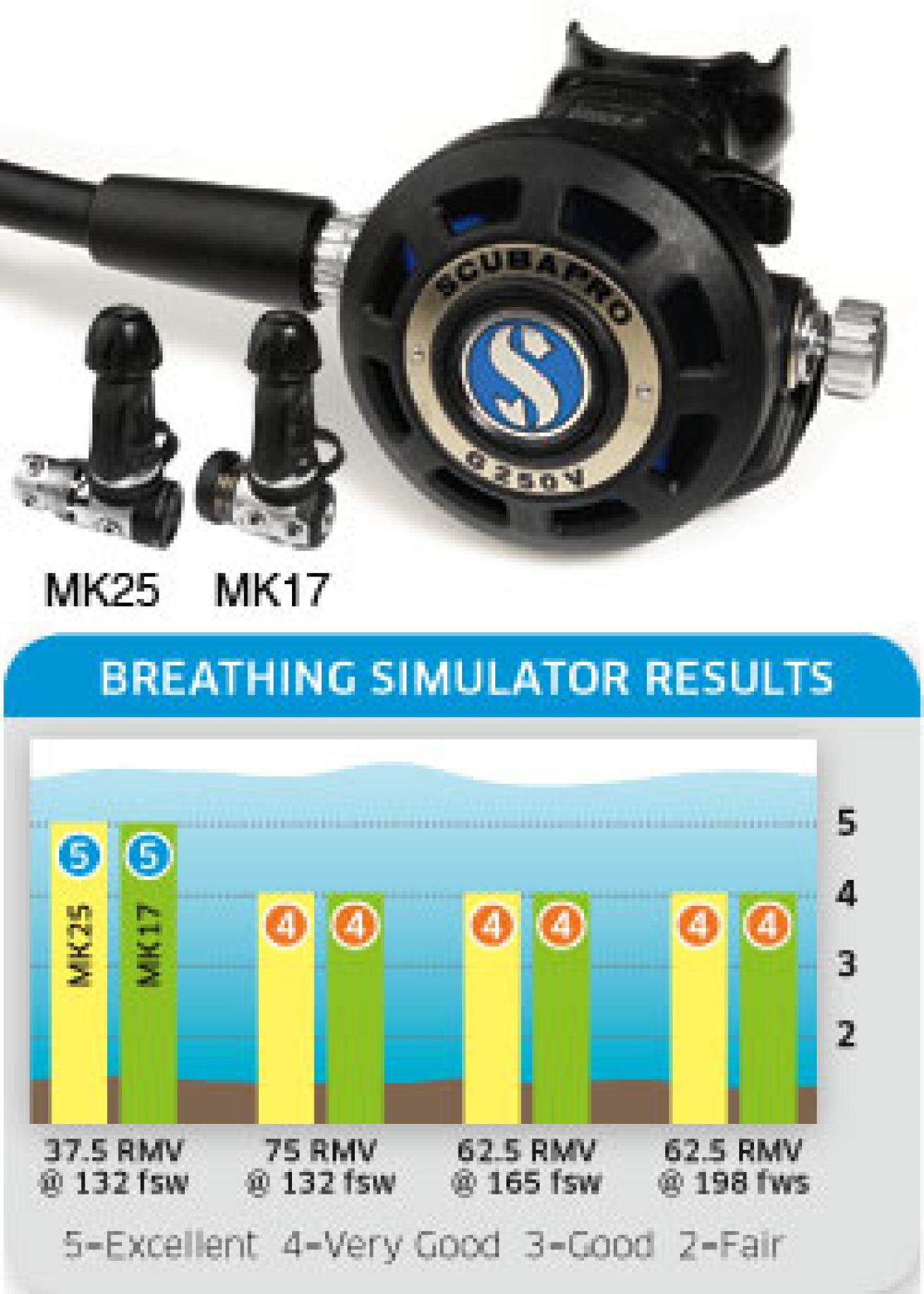
| | Scubapro - MK25/G250V & MK17/G250V|
Features: The G250V is a re-released version of Scubapro's classic second stage, and the full-sized, pneumatically balanced breather is as popular as ever. It offers two user adjustments: a Venturi Initiated Vacuum Assist (VIVA) that controls surface free-flows, and a breathing resistance knob. Scubapro's flagship MK25 first stage is a balanced piston design with two high-pressure ports and five low-pressure ports on a turret to accommodate convenient hose routing. It also has an external intermediate pressure adjustment for maintaining peak performance between service intervals. If you prefer a balanced diaphragm first stage, the MK17 features a dry ambient chamber that shields the moving parts from cold and contaminated water. It offers two high-pressure ports and four low-pressure ports, all angled for direct routing.
Performance: Both combinations offer smooth, dry breathing in all positions, and the orthodontic mouthpiece made the G250V one of most comfortable in this test group. The center-case button purge is powerful, and the VIVA switch is extra-large, making it easy to grab. As a bonus, the purge button can be recessed during storage to preserve the life of the second stage seat. On the ANSTI breathing machine, both regs earned Excellent to Very Good scores.
Bottom Line: Take your pick--you can't go wrong with either of these top performers.
Price: MK 25/G250V $626; MK 17/G250V $595
Weight: MK 25/G250V--2 pounds, 12 ounces; MK 17/G250V--2 pounds, 13 ounces.
Web: www.scubapro.com
|||| |---|---|---|
|<
table>
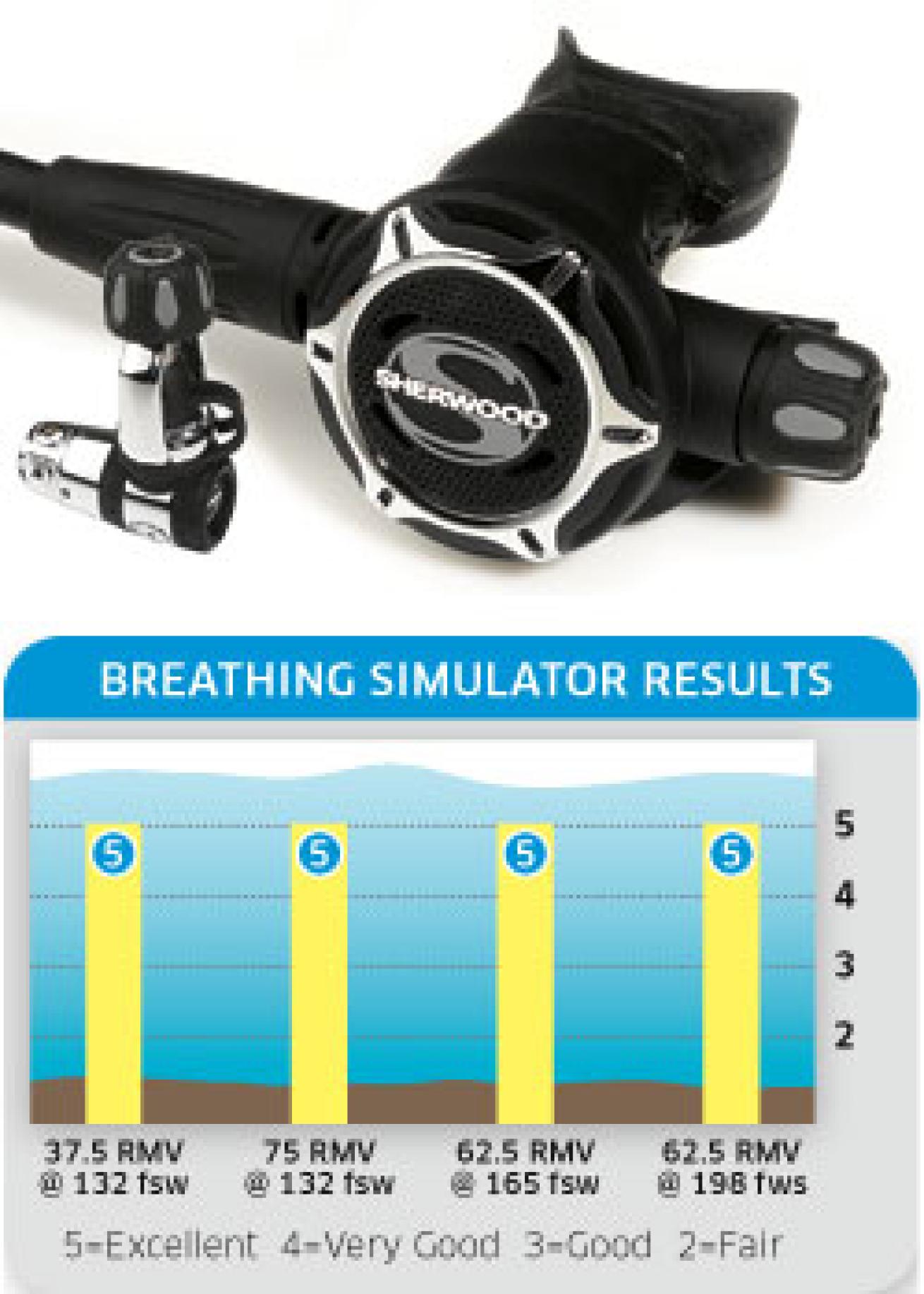
| | Sherwood Scuba - SR1|
Features: The new SR1 from Sherwood Scuba was the standout regulator of this review, offering innovative design, clever features and outstanding breathing performance. The first stage is polished chrome over brass with five low-pressure ports on a turret and two high-pressure ports. It's a balanced piston design, but with a unique air-filled dry-sealed spring chamber that is completely environmentally sealed. The pneumatically balanced second stage features a single control knob that simultaneously adjusts both the venturi control and breathing resistance. And between dives, a SMART demand lever lightens the load on the valve seat for extended life and performance. Bonus: The second stage also comes with an external fitting for adjusting lever height, making life easier for your technician.
Performance: Underwater, the SR1 delivers dry and effortless breathing in all positions, thanks in part to an oversized exhaust valve, which reduces exhalation resistance. This design helps reduce overall work of breathing, and yielded Excellent ANSTI machine scores in all tests. In fact, the SR1 was one of only four regs to earn perfect simulator scores. The flexible front-cover purge provides a forceful clearing action, and the low-profile exhaust tee does a good job of deflecting bubbles, both when stationary and when moving forward in the water.
Bottom Line: The SR1 is a solid breather, combining proven regulator design with cutting-edge features for excellent performance.
Price: $640
Weight: 2 pounds, 5 ounces.
Under $500
|||| |---|---|---|
|<
table>
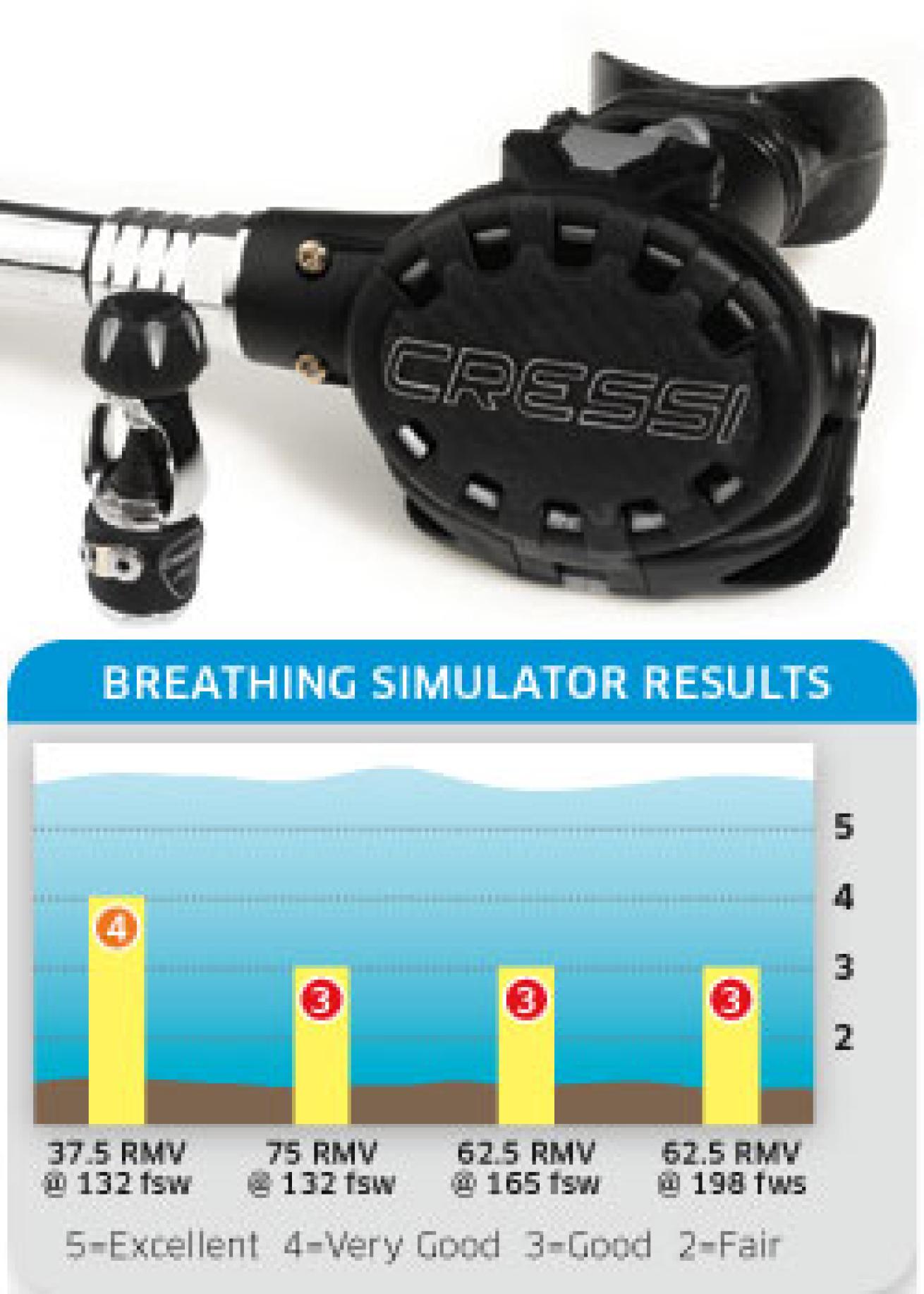
| | Cressi-sub - Ellipse Black/MC5|
Features: At just under 2 pounds, the Ellipse Black/MC5 is one of the lightest regulators of this test group and built to travel. The MC5 balanced-diaphragm first stage is a new design. Encased in a protective elastomer shell, it features three angled low-pressure ports and one high-pressure port. The Ellipse Black second stage is made of lightweight, high-impact thermopolymer and sports a full front-cover purge and a large dive/pre-dive switch.
Performance: Underwater, the compact second stage was light in the mouth, breathed dry in all positions and cleared easily, either with a puff of air or a blast from the big purge cover. Even though it was one of the smallest second stages in this review, it had one of the largest venturi controls and purge button, for easy operation, even with gloves. Exhaust bubbles were a little more noticeable than other regs in this review, but that's to be expected with such a compact exhaust tee. The top-mounted venturi adjustment lever was easy to find and effective in preventing surface free-flows. During in-water dives, we rated it highly for comfort thanks to a light feel and a soft mouthpiece. On the ANSTI breathing machine, it earned Very Good scores within recreational diving range and Good scores under extreme conditions.
Bottom Line: Extremely lightweight and priced at a very attractive MSRP.
Price: $299
Weight: 1 pound, 15 ounces.
Web: www.cressisubusa.com
|||| |---|---|---|
|<
table>
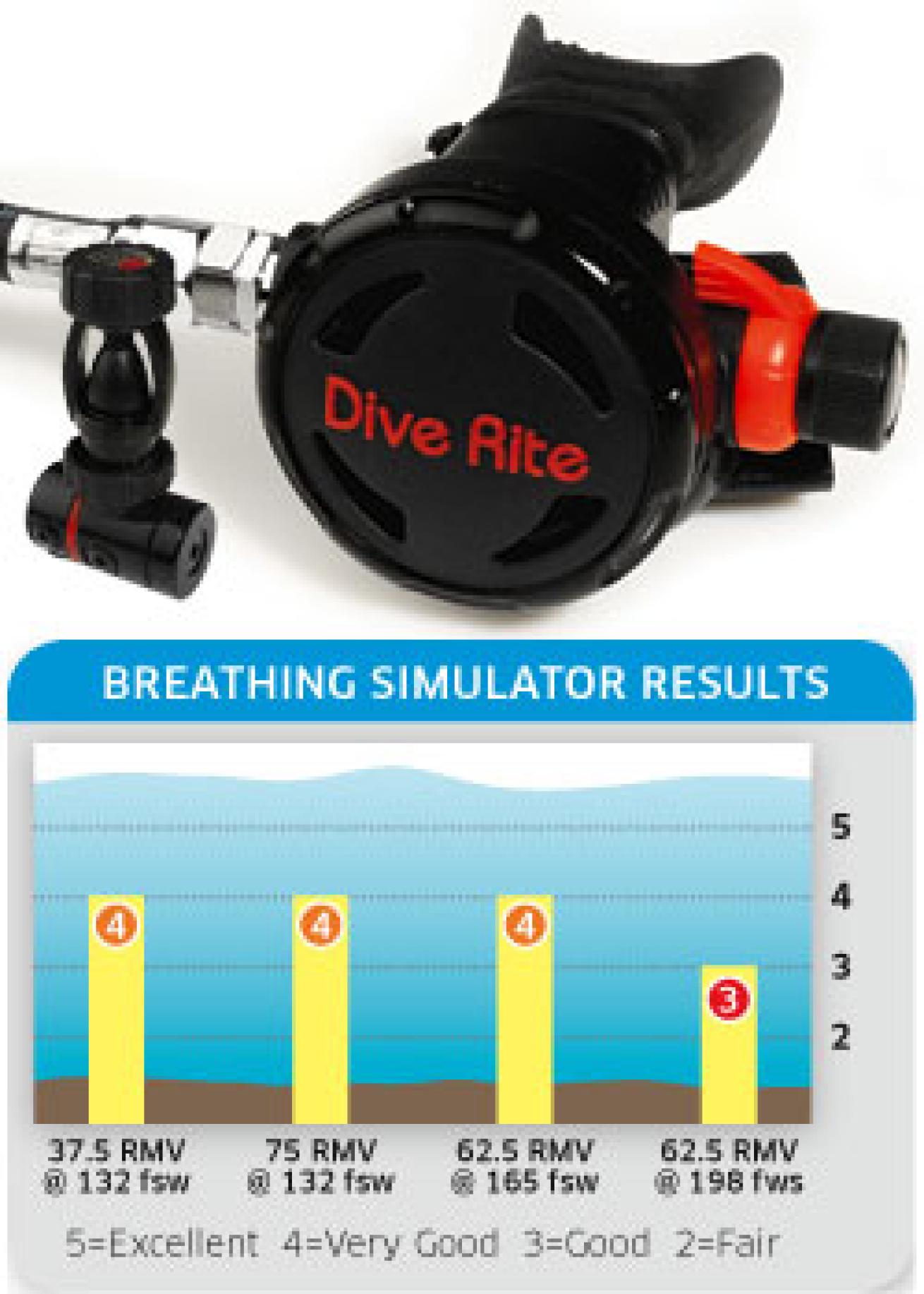
| | Dive Rite - 3000|
Features: This tech-ready reg pairs Dive Rite's proven 1208 diaphragm first stage with the new 3000-series second stage to create a full-featured breather. The first stage offers two high-pressure ports with four low-pressure ports located on a rotating turret to provide easy hose placement. It comes standard with a 300-bar DIN connector and yoke adapter and features oxygen-compatible Viton O-rings. The new 3000 pneumatically balanced second stage presents a full-size body with large flow control and venturi adjustments. All internal moving parts are Teflon-coated for cold water and use Viton O-rings with oxygen-compatible lubricant.
Performance: The reg delivered Very Good performance in all but the most extreme breathing machine tests and in fact, turned in the best overall ANSTI performance of any regulator in the Under $500 class. Like dialing in your precise breathing resistance? The flow control knob on the 3000 offers 4.5 full rotations and covers a noticeably wide range of control over breathing resistance. In Ergo tests, this new 3000 stage offered very good performance across the board. Its plastic case was light in the mouth, and the full front-cover purge is flexible and clears easily. It was also a dry, stable breather that offered great all-around performance during our test dives.
Bottom Line: The 3000 offers very good performance, versatile user controls and is ready for DIN or yoke tank connection.
Price: $450
Weight: 3 pounds, 1 ounce (yoke).
Web: www.diverite.com
|||| |---|---|---|
|<
table>
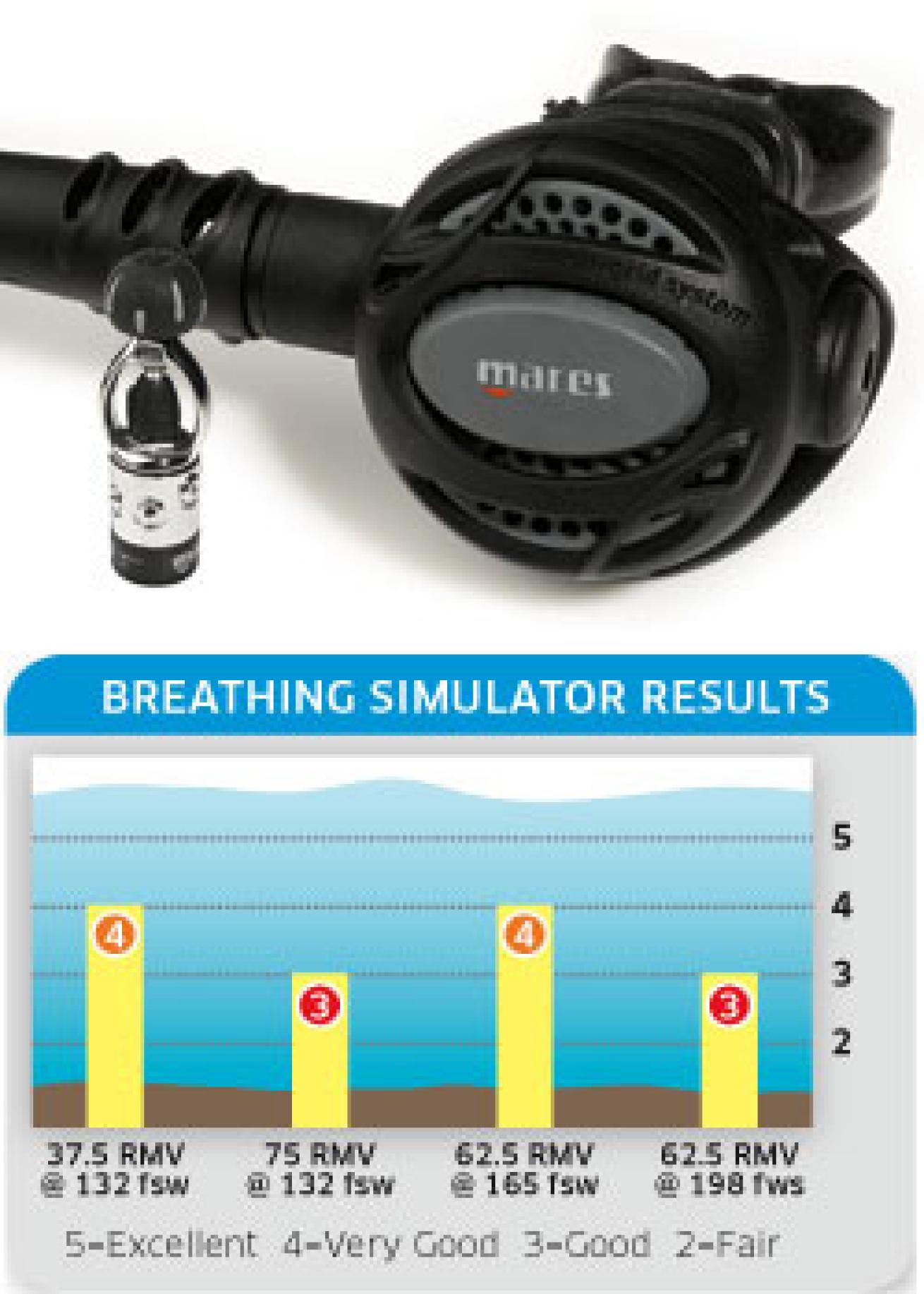
| | Mares - Prestige 12|
Features: While it's in the economy class of regulators, the MR12T balanced diaphragm first stage has been and continues to be a reliable workhorse. It has all the performance features of the company's high-end models, including the new Tri-Material first-stage valve and the Dynamic Flow Control low-pressure port that's dedicated to the primary second stage. The Prestige second stage features a mid-size case made from durable thermoplastic and a simplified design without user adjustments. It also has a large flexible purge cover.
Performance: On our test dives, we found the Prestige light, comfortable and easy to use. It offered worry-free, dry breathing in all swimming positions, and on the ANSTI machine, it turned in work of breathing numbers that ranged from Very Good to Good in all depth/workload tests. The plastic second stage was comfortable with a soft mouthpiece and sits lightly and comfortably in the mouth. A small exhaust tee reduces drag, but the trade-off is greater bubble interference. All-in-all, we found the Prestige 12 to be a reliable regulator with the performance and simplicity that make it an ideal entry-level reg or a trusty backup.
Bottom Line: This is a simple, dependable workhorse reg.
Price: $400
Weight: 2 pounds, 6 ounces.
Web: www.diverite.com
|||| |---|---|---|
|<
table>
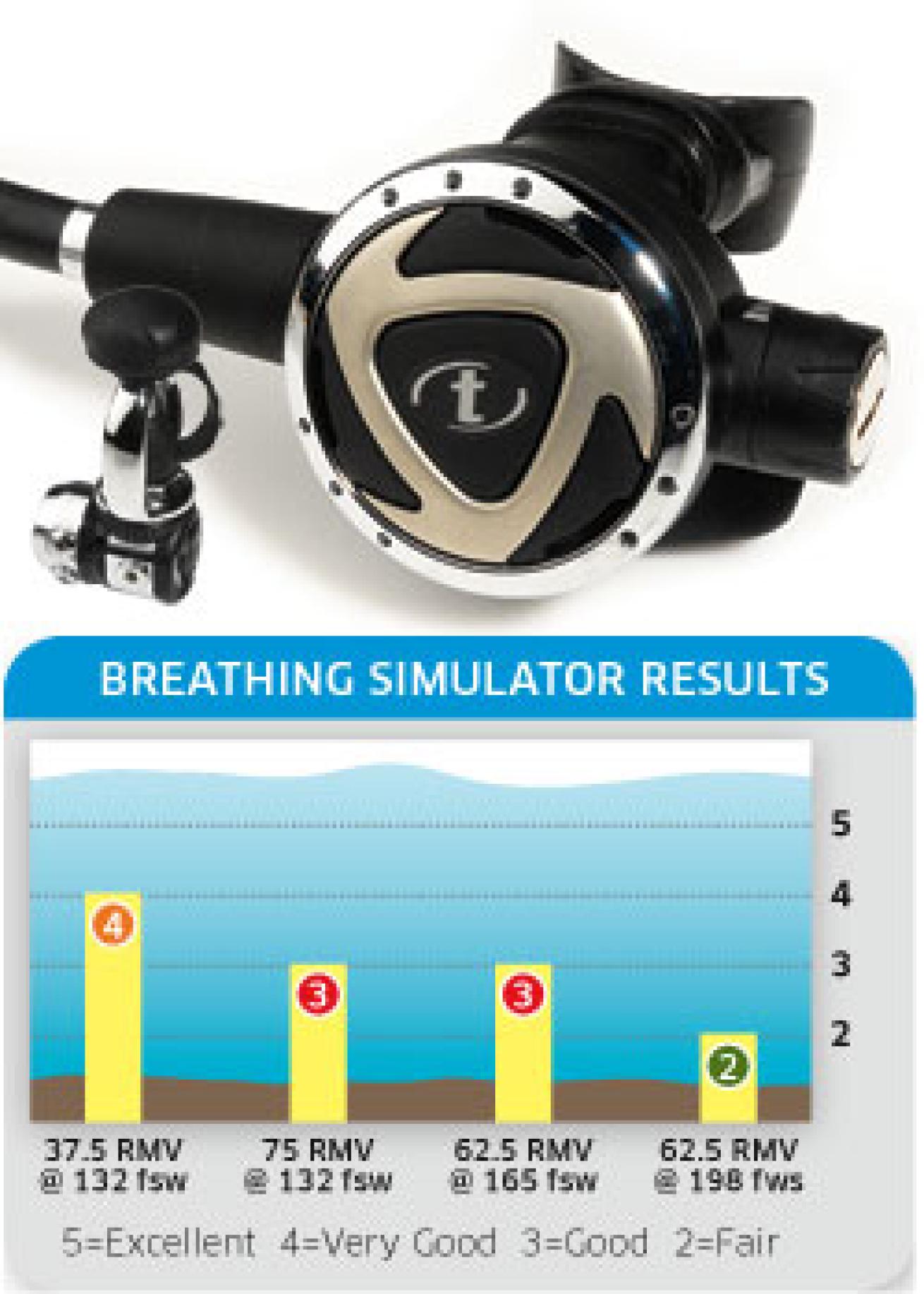
| | Tusa - RS-530|
Features: This combination starts with Tusa's compact R-500 balanced piston first stage, which features a full complement of four low-pressure and two high-pressure ports and is equipped with a quick-adjustment screw for fine-tuning performance. At the end of the low-pressure hose is the company's S-30 thermoplastic second stage featuring a breathing resistance adjustment knob for on-the-swim flow control. It also has a new orthodontic mouthpiece and a chrome trim ring locking down a full front-cover purge.
Performance: On our test dives, we noticed the mouthpiece right away. It features elongated bite tabs and required less bite pressure to hold comfortably in the mouth. The reg earned Very Good ratings in most ergo categories. The breathing resistance knob is clearly marked and offers a full turn of adjustment with an indexed click that allows precise tuning, and in the wide-open setting, cracking effort was followed by a dry, smooth inhalation. It also offered minimal bubble interference. The center purge is easy to locate and quick to clear. On the breathing machine, it excelled at recreational depths and workloads while receiving Very Good and Good scores in the other three tests.
Bottom Line: The RS-530 is a comfortable reg with the added bonus of being the least expensive balanced piston first stage in this review.
Price: $399
Weight: 2 pounds, 7 ounces.
Web: www.diverite.com
Breathing Rates and Depths
Regulators are tested at four different RMV/depth combinations (RMV stands for Respiratory Minute Volumes--basically the amount of gas that is ventilated through the lungs in one minute). Here are the tests and what they represent:
37.5 RMV @ 132 fsw A somewhat aggressive breathing rate at the maximum recreational diving depth. A physically fit recreational diver might breathe at this rate while swimming a long distance. (A relaxed diver on a drift dive will probably be breathing at 22 RMV or less.) A diver could theoretically maintain 37.5 RMV for 5 minutes or longer without becoming significantly winded.
75 RMV @ 132 fsw An extremely aggressive breathing rate at the maximum recreational diving depth. A diver in excellent condition can breathe at 75 RMV for about one minute. This test represents how a reg might perform with a single diver breathing at an extremely heavy work rate. It also serves as a loose simulation of the stress a reg would be under if two divers were breathing off the same first stage in an air-sharing situation. Only the U.S. Navy and Scuba Lab use this breathing rate to help identify the outer limits of a reg's performance.
62.5 RMV @ 165 fsw All regs sold in the European Common Market must pass a test standard known as EN250, which uses this RMV/depth as its benchmark. For this reason, it's also the depth and breathing rate most commonly used by manufacturers to test regulators. This is a very aggressive breathing rate. A recreational diver in excellent condition chasing a bat ray through open water would probably be able to maintain 62.5 RMV for only a few minutes.
62.5 RMV @ 198 fsw This is the U.S. Navy's Class A test depth and breathing rate, although they use a higher supply pressure than our standard 725-760 psi. We conduct this extreme test (no diver should ever breath this aggressively at this great a depth with this little air left) to explore the outer limits of a reg's performance.
Scoring the Results
A machine as accurate as the ANSTI simulator can differentiate j/l measurements to tenths and even hundredths of a point. Human divers, however, can't detect differences much smaller than about 0.5 j/l. So for the sake of simplicity, we translate j/l measurements into scores on a 2 to 5 scale as follows:
5 = Excellent: A total WOB of 1.05 j/l or less.
4 = Very Good: A total WOB of 1.06 to 1.55 j/l.
3 = Good: A total WOB from 1.56 to 2.25 j/l.
2 = Fair: A total WOB of 2.26 to 3.0 j/l.
If a reg is unable to achieve the RMV/Depth category, its maximum depth within test parameters is recorded instead of a score.
How and Why We Test Regulators
The goal of our exclusive Scuba Lab Reviews (found only in Scuba Diving magazine and archived on scuba diving.com) is to help you be an informed consumer of dive gear.
To fulfill this mission when testing regulators, we use an industry-standard ANSTI wet breathing machine, which is capable of measuring minute differences in the inhalation and exhalation resistance at a variety of depths and breathing rates. Following internationally accepted test standards, a regulator's work of breathing (WOB) is measured in joules per liter for each complete inhale/exhale cycle, during which the highest inhale or exhalation pressure experienced by the "diver" should never exceed 25 millibars or a total WOB of 3 j/l.
If a reg exceeds either parameter, it "fails" our test, but that doesn't mean that it stops delivering air--only that the breathing resistance at some point in the cycle is higher than what is common for most modern regulators. All simulator tests are performed at a supply pressure of 725-760 psi. If a regulator can perform well at this supply pressure, it will perform as well or better at higher supply pressures.

